Drivers to maintain the Quality Standards of Raw Materials in the Construction Industry
VerifiedAdded on 2023/01/12
|31
|11001
|61
AI Summary
This study aims to present the impact of the quality check of the raw material in the construction industry, along with that it also discusses the faults of engineering that are linked with this industry. The study focuses on the drivers that help in maintaining the quality of raw materials and the challenges faced by the construction industry in maintaining quality.
Contribute Materials
Your contribution can guide someone’s learning journey. Share your
documents today.
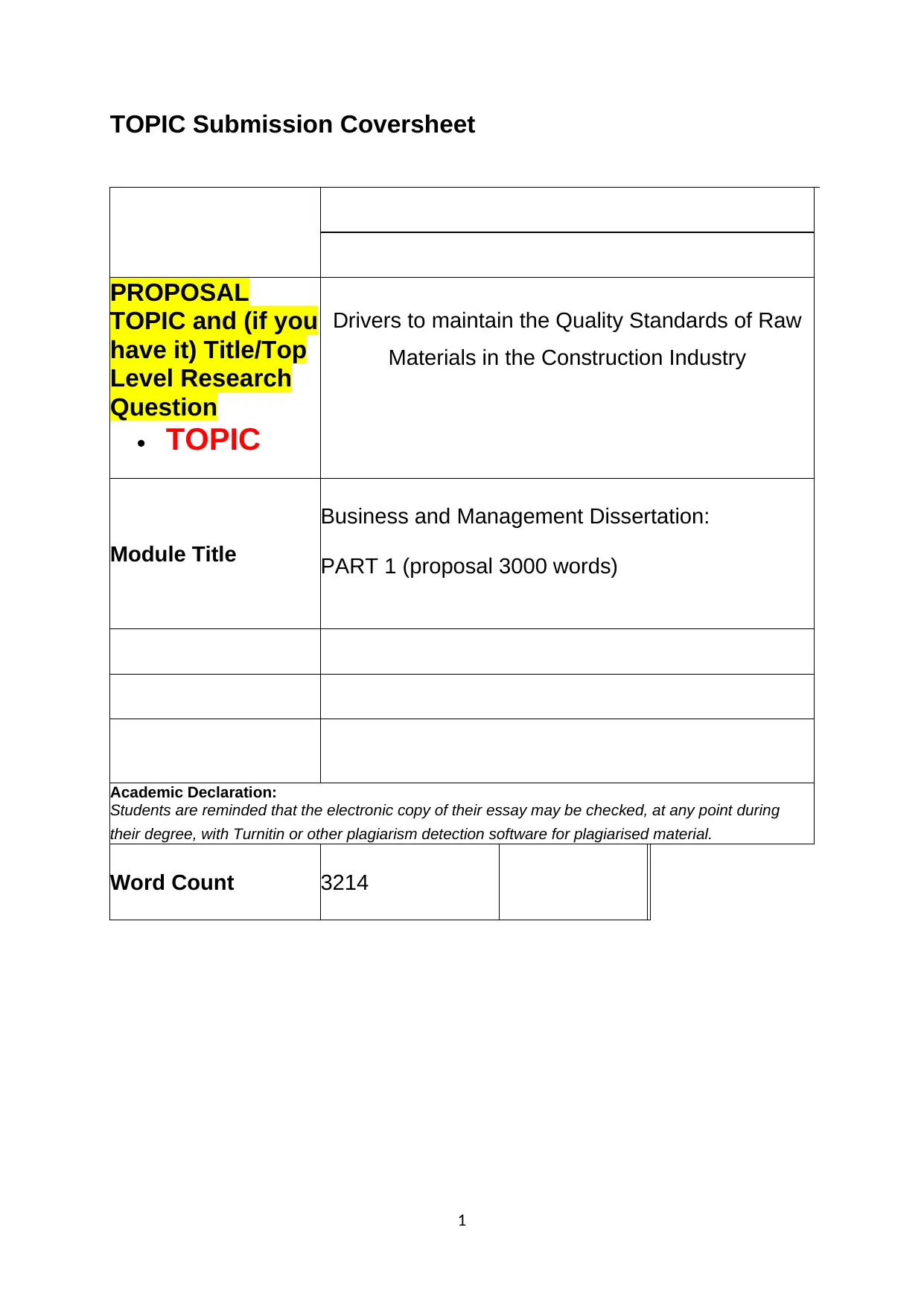
TOPIC Submission Coversheet
PROPOSAL
TOPIC and (if you
have it) Title/Top
Level Research
Question
TOPIC
Drivers to maintain the Quality Standards of Raw
Materials in the Construction Industry
Module Title
Business and Management Dissertation:
PART 1 (proposal 3000 words)
Academic Declaration:
Students are reminded that the electronic copy of their essay may be checked, at any point during
their degree, with Turnitin or other plagiarism detection software for plagiarised material.
Word Count 3214
1
PROPOSAL
TOPIC and (if you
have it) Title/Top
Level Research
Question
TOPIC
Drivers to maintain the Quality Standards of Raw
Materials in the Construction Industry
Module Title
Business and Management Dissertation:
PART 1 (proposal 3000 words)
Academic Declaration:
Students are reminded that the electronic copy of their essay may be checked, at any point during
their degree, with Turnitin or other plagiarism detection software for plagiarised material.
Word Count 3214
1
Secure Best Marks with AI Grader
Need help grading? Try our AI Grader for instant feedback on your assignments.
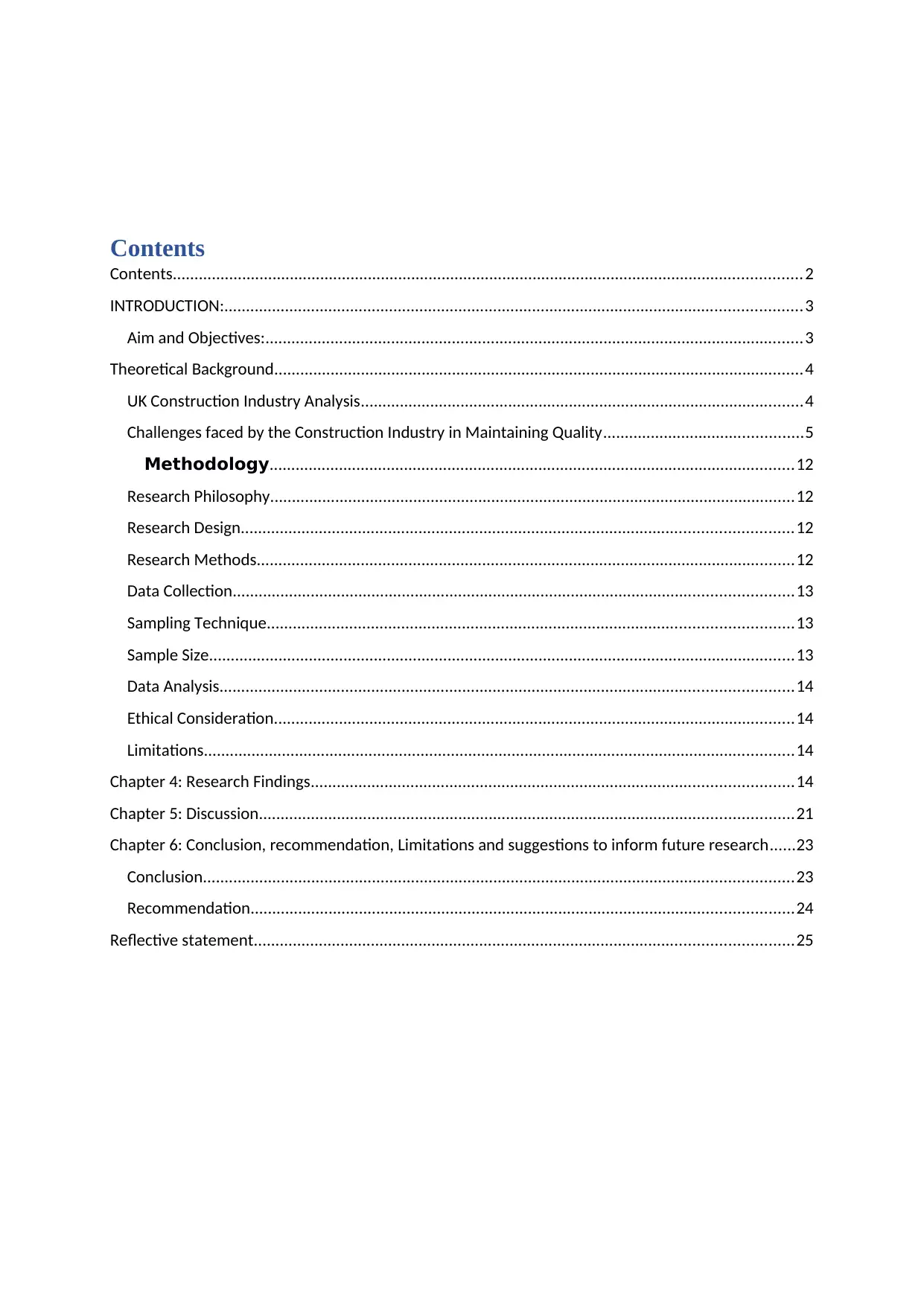
Contents
Contents.................................................................................................................................................2
INTRODUCTION:.....................................................................................................................................3
Aim and Objectives:............................................................................................................................3
Theoretical Background..........................................................................................................................4
UK Construction Industry Analysis......................................................................................................4
Challenges faced by the Construction Industry in Maintaining Quality..............................................5
Methodology.........................................................................................................................12
Research Philosophy.........................................................................................................................12
Research Design...............................................................................................................................12
Research Methods............................................................................................................................12
Data Collection.................................................................................................................................13
Sampling Technique.........................................................................................................................13
Sample Size.......................................................................................................................................13
Data Analysis....................................................................................................................................14
Ethical Consideration........................................................................................................................14
Limitations........................................................................................................................................14
Chapter 4: Research Findings...............................................................................................................14
Chapter 5: Discussion...........................................................................................................................21
Chapter 6: Conclusion, recommendation, Limitations and suggestions to inform future research......23
Conclusion........................................................................................................................................23
Recommendation.............................................................................................................................24
Reflective statement............................................................................................................................25
Contents.................................................................................................................................................2
INTRODUCTION:.....................................................................................................................................3
Aim and Objectives:............................................................................................................................3
Theoretical Background..........................................................................................................................4
UK Construction Industry Analysis......................................................................................................4
Challenges faced by the Construction Industry in Maintaining Quality..............................................5
Methodology.........................................................................................................................12
Research Philosophy.........................................................................................................................12
Research Design...............................................................................................................................12
Research Methods............................................................................................................................12
Data Collection.................................................................................................................................13
Sampling Technique.........................................................................................................................13
Sample Size.......................................................................................................................................13
Data Analysis....................................................................................................................................14
Ethical Consideration........................................................................................................................14
Limitations........................................................................................................................................14
Chapter 4: Research Findings...............................................................................................................14
Chapter 5: Discussion...........................................................................................................................21
Chapter 6: Conclusion, recommendation, Limitations and suggestions to inform future research......23
Conclusion........................................................................................................................................23
Recommendation.............................................................................................................................24
Reflective statement............................................................................................................................25
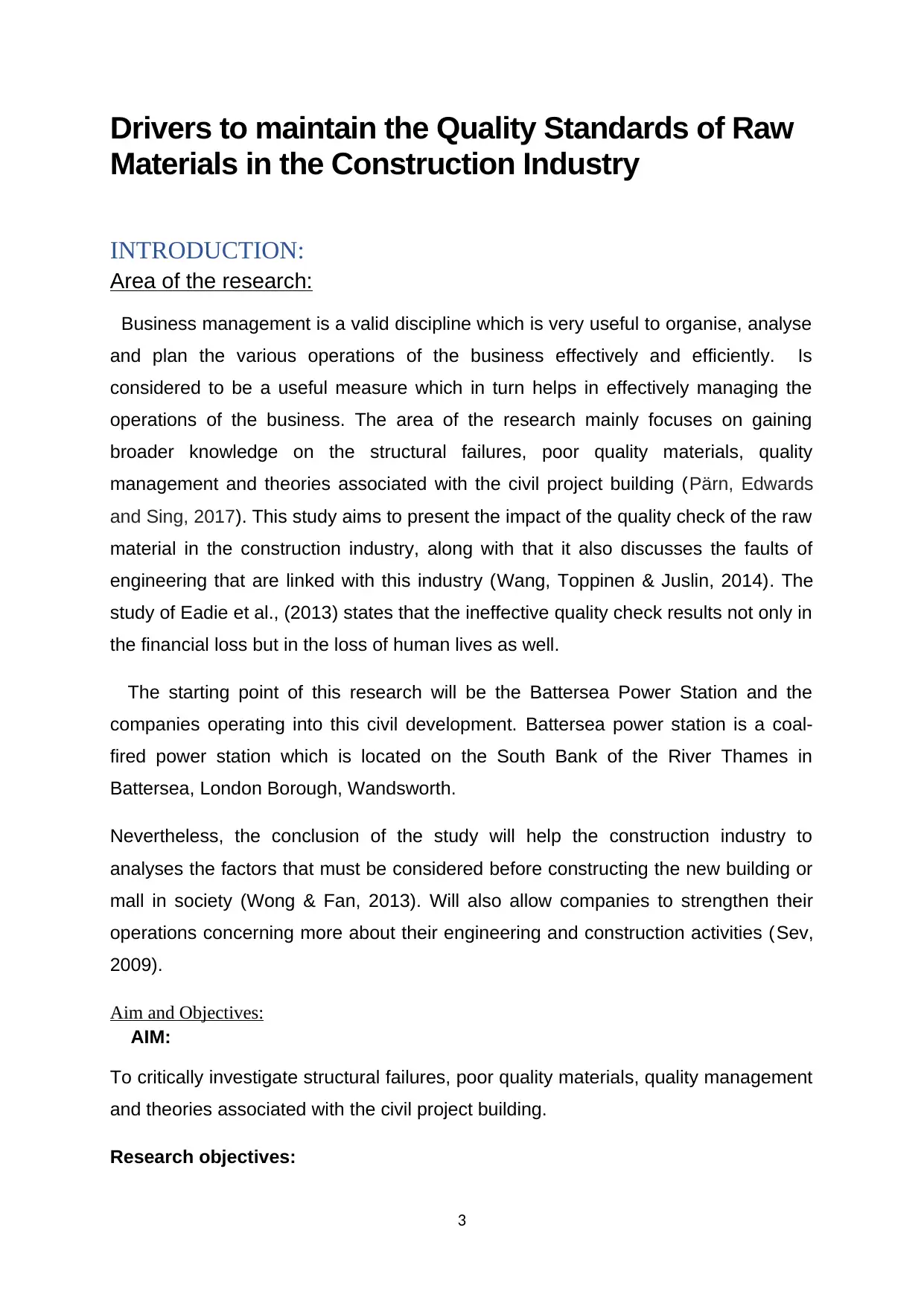
Drivers to maintain the Quality Standards of Raw
Materials in the Construction Industry
INTRODUCTION:
Area of the research:
Business management is a valid discipline which is very useful to organise, analyse
and plan the various operations of the business effectively and efficiently. Is
considered to be a useful measure which in turn helps in effectively managing the
operations of the business. The area of the research mainly focuses on gaining
broader knowledge on the structural failures, poor quality materials, quality
management and theories associated with the civil project building (Pärn, Edwards
and Sing, 2017). This study aims to present the impact of the quality check of the raw
material in the construction industry, along with that it also discusses the faults of
engineering that are linked with this industry (Wang, Toppinen & Juslin, 2014). The
study of Eadie et al., (2013) states that the ineffective quality check results not only in
the financial loss but in the loss of human lives as well.
The starting point of this research will be the Battersea Power Station and the
companies operating into this civil development. Battersea power station is a coal-
fired power station which is located on the South Bank of the River Thames in
Battersea, London Borough, Wandsworth.
Nevertheless, the conclusion of the study will help the construction industry to
analyses the factors that must be considered before constructing the new building or
mall in society (Wong & Fan, 2013). Will also allow companies to strengthen their
operations concerning more about their engineering and construction activities (Sev,
2009).
Aim and Objectives:
AIM:
To critically investigate structural failures, poor quality materials, quality management
and theories associated with the civil project building.
Research objectives:
3
Materials in the Construction Industry
INTRODUCTION:
Area of the research:
Business management is a valid discipline which is very useful to organise, analyse
and plan the various operations of the business effectively and efficiently. Is
considered to be a useful measure which in turn helps in effectively managing the
operations of the business. The area of the research mainly focuses on gaining
broader knowledge on the structural failures, poor quality materials, quality
management and theories associated with the civil project building (Pärn, Edwards
and Sing, 2017). This study aims to present the impact of the quality check of the raw
material in the construction industry, along with that it also discusses the faults of
engineering that are linked with this industry (Wang, Toppinen & Juslin, 2014). The
study of Eadie et al., (2013) states that the ineffective quality check results not only in
the financial loss but in the loss of human lives as well.
The starting point of this research will be the Battersea Power Station and the
companies operating into this civil development. Battersea power station is a coal-
fired power station which is located on the South Bank of the River Thames in
Battersea, London Borough, Wandsworth.
Nevertheless, the conclusion of the study will help the construction industry to
analyses the factors that must be considered before constructing the new building or
mall in society (Wong & Fan, 2013). Will also allow companies to strengthen their
operations concerning more about their engineering and construction activities (Sev,
2009).
Aim and Objectives:
AIM:
To critically investigate structural failures, poor quality materials, quality management
and theories associated with the civil project building.
Research objectives:
3
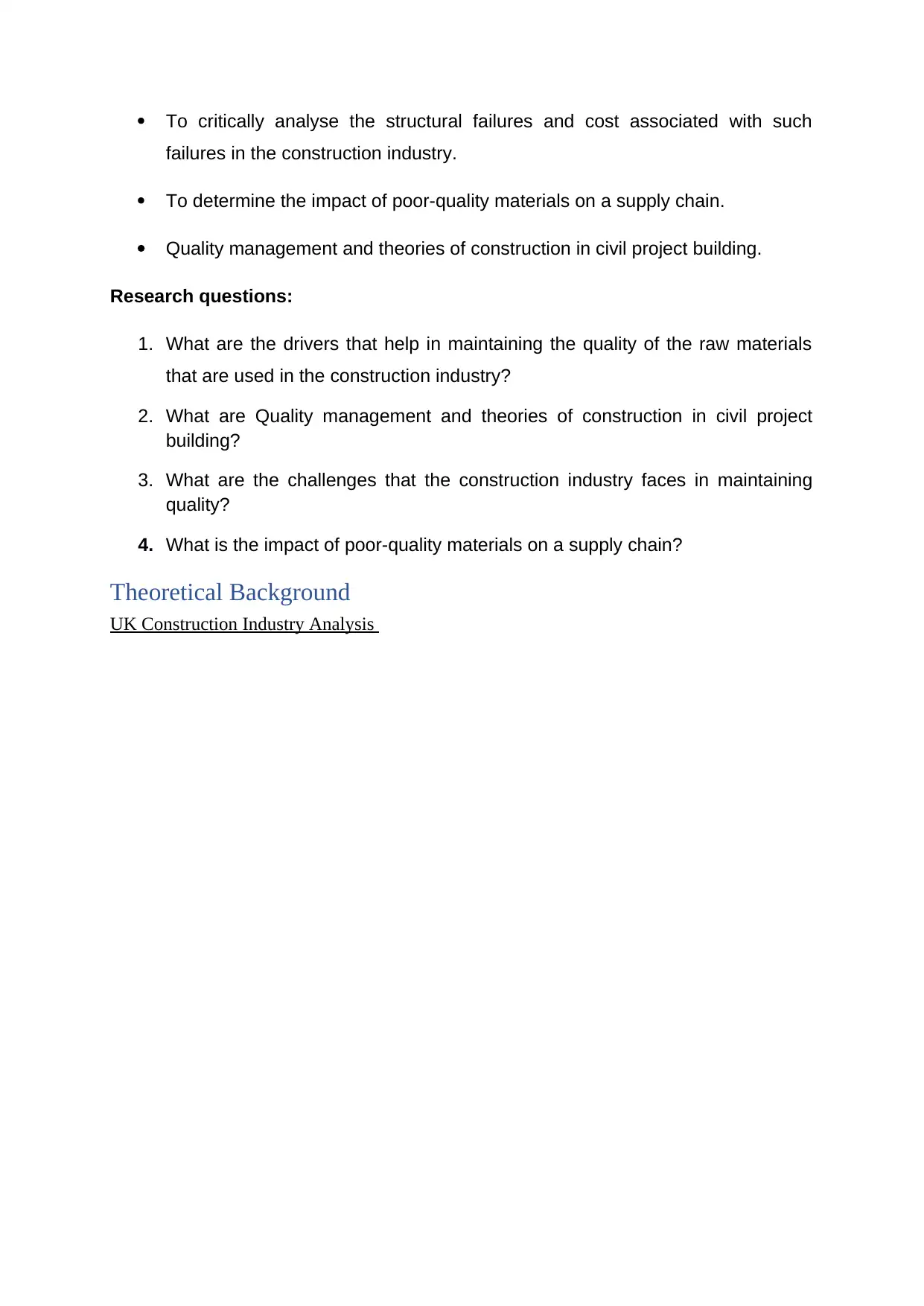
To critically analyse the structural failures and cost associated with such
failures in the construction industry.
To determine the impact of poor-quality materials on a supply chain.
Quality management and theories of construction in civil project building.
Research questions:
1. What are the drivers that help in maintaining the quality of the raw materials
that are used in the construction industry?
2. What are Quality management and theories of construction in civil project
building?
3. What are the challenges that the construction industry faces in maintaining
quality?
4. What is the impact of poor-quality materials on a supply chain?
Theoretical Background
UK Construction Industry Analysis
failures in the construction industry.
To determine the impact of poor-quality materials on a supply chain.
Quality management and theories of construction in civil project building.
Research questions:
1. What are the drivers that help in maintaining the quality of the raw materials
that are used in the construction industry?
2. What are Quality management and theories of construction in civil project
building?
3. What are the challenges that the construction industry faces in maintaining
quality?
4. What is the impact of poor-quality materials on a supply chain?
Theoretical Background
UK Construction Industry Analysis
Secure Best Marks with AI Grader
Need help grading? Try our AI Grader for instant feedback on your assignments.
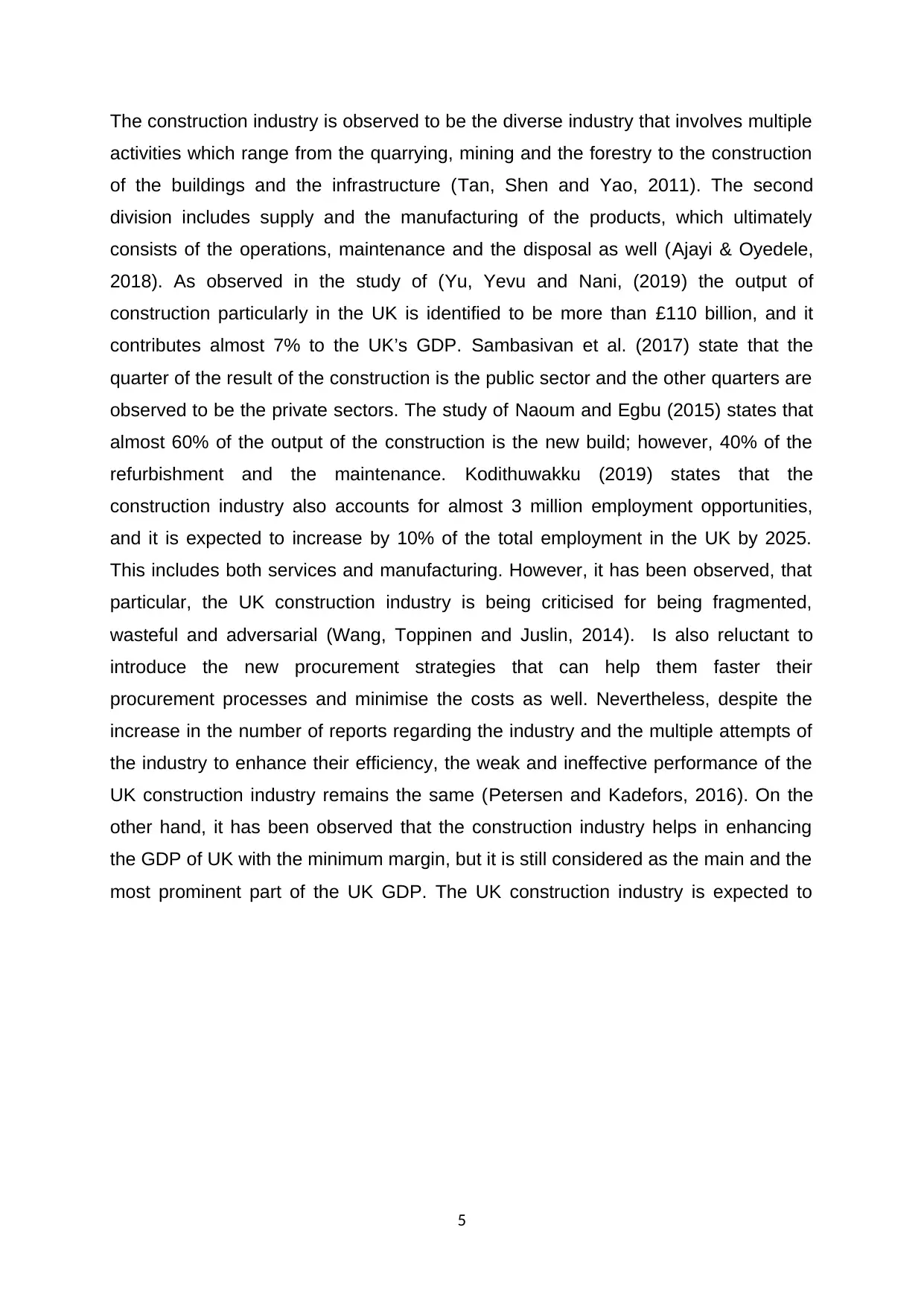
The construction industry is observed to be the diverse industry that involves multiple
activities which range from the quarrying, mining and the forestry to the construction
of the buildings and the infrastructure (Tan, Shen and Yao, 2011). The second
division includes supply and the manufacturing of the products, which ultimately
consists of the operations, maintenance and the disposal as well (Ajayi & Oyedele,
2018). As observed in the study of (Yu, Yevu and Nani, (2019) the output of
construction particularly in the UK is identified to be more than £110 billion, and it
contributes almost 7% to the UK’s GDP. Sambasivan et al. (2017) state that the
quarter of the result of the construction is the public sector and the other quarters are
observed to be the private sectors. The study of Naoum and Egbu (2015) states that
almost 60% of the output of the construction is the new build; however, 40% of the
refurbishment and the maintenance. Kodithuwakku (2019) states that the
construction industry also accounts for almost 3 million employment opportunities,
and it is expected to increase by 10% of the total employment in the UK by 2025.
This includes both services and manufacturing. However, it has been observed, that
particular, the UK construction industry is being criticised for being fragmented,
wasteful and adversarial (Wang, Toppinen and Juslin, 2014). Is also reluctant to
introduce the new procurement strategies that can help them faster their
procurement processes and minimise the costs as well. Nevertheless, despite the
increase in the number of reports regarding the industry and the multiple attempts of
the industry to enhance their efficiency, the weak and ineffective performance of the
UK construction industry remains the same (Petersen and Kadefors, 2016). On the
other hand, it has been observed that the construction industry helps in enhancing
the GDP of UK with the minimum margin, but it is still considered as the main and the
most prominent part of the UK GDP. The UK construction industry is expected to
5
activities which range from the quarrying, mining and the forestry to the construction
of the buildings and the infrastructure (Tan, Shen and Yao, 2011). The second
division includes supply and the manufacturing of the products, which ultimately
consists of the operations, maintenance and the disposal as well (Ajayi & Oyedele,
2018). As observed in the study of (Yu, Yevu and Nani, (2019) the output of
construction particularly in the UK is identified to be more than £110 billion, and it
contributes almost 7% to the UK’s GDP. Sambasivan et al. (2017) state that the
quarter of the result of the construction is the public sector and the other quarters are
observed to be the private sectors. The study of Naoum and Egbu (2015) states that
almost 60% of the output of the construction is the new build; however, 40% of the
refurbishment and the maintenance. Kodithuwakku (2019) states that the
construction industry also accounts for almost 3 million employment opportunities,
and it is expected to increase by 10% of the total employment in the UK by 2025.
This includes both services and manufacturing. However, it has been observed, that
particular, the UK construction industry is being criticised for being fragmented,
wasteful and adversarial (Wang, Toppinen and Juslin, 2014). Is also reluctant to
introduce the new procurement strategies that can help them faster their
procurement processes and minimise the costs as well. Nevertheless, despite the
increase in the number of reports regarding the industry and the multiple attempts of
the industry to enhance their efficiency, the weak and ineffective performance of the
UK construction industry remains the same (Petersen and Kadefors, 2016). On the
other hand, it has been observed that the construction industry helps in enhancing
the GDP of UK with the minimum margin, but it is still considered as the main and the
most prominent part of the UK GDP. The UK construction industry is expected to
5
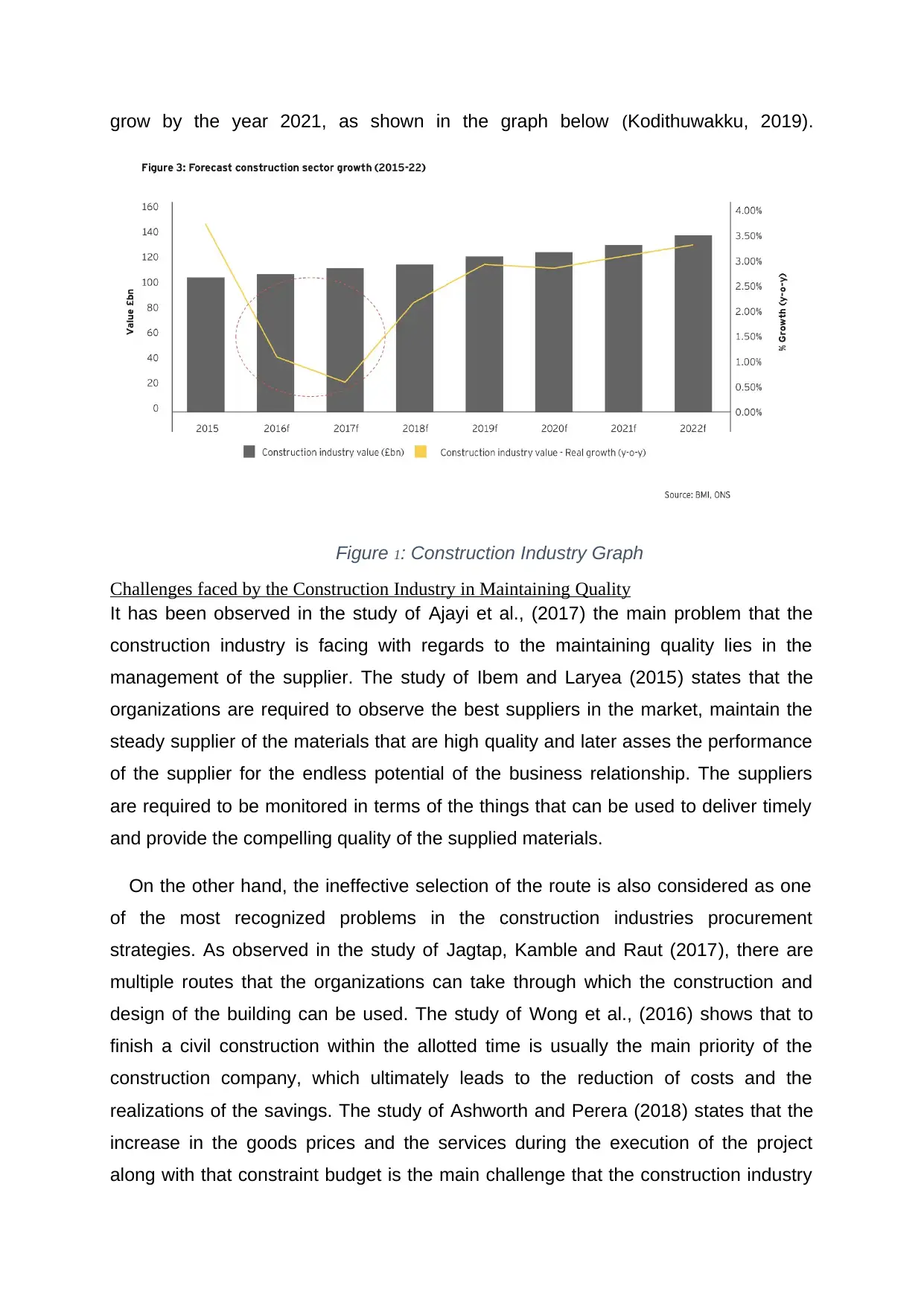
grow by the year 2021, as shown in the graph below (Kodithuwakku, 2019).
Figure 1: Construction Industry Graph
Challenges faced by the Construction Industry in Maintaining Quality
It has been observed in the study of Ajayi et al., (2017) the main problem that the
construction industry is facing with regards to the maintaining quality lies in the
management of the supplier. The study of Ibem and Laryea (2015) states that the
organizations are required to observe the best suppliers in the market, maintain the
steady supplier of the materials that are high quality and later asses the performance
of the supplier for the endless potential of the business relationship. The suppliers
are required to be monitored in terms of the things that can be used to deliver timely
and provide the compelling quality of the supplied materials.
On the other hand, the ineffective selection of the route is also considered as one
of the most recognized problems in the construction industries procurement
strategies. As observed in the study of Jagtap, Kamble and Raut (2017), there are
multiple routes that the organizations can take through which the construction and
design of the building can be used. The study of Wong et al., (2016) shows that to
finish a civil construction within the allotted time is usually the main priority of the
construction company, which ultimately leads to the reduction of costs and the
realizations of the savings. The study of Ashworth and Perera (2018) states that the
increase in the goods prices and the services during the execution of the project
along with that constraint budget is the main challenge that the construction industry
Figure 1: Construction Industry Graph
Challenges faced by the Construction Industry in Maintaining Quality
It has been observed in the study of Ajayi et al., (2017) the main problem that the
construction industry is facing with regards to the maintaining quality lies in the
management of the supplier. The study of Ibem and Laryea (2015) states that the
organizations are required to observe the best suppliers in the market, maintain the
steady supplier of the materials that are high quality and later asses the performance
of the supplier for the endless potential of the business relationship. The suppliers
are required to be monitored in terms of the things that can be used to deliver timely
and provide the compelling quality of the supplied materials.
On the other hand, the ineffective selection of the route is also considered as one
of the most recognized problems in the construction industries procurement
strategies. As observed in the study of Jagtap, Kamble and Raut (2017), there are
multiple routes that the organizations can take through which the construction and
design of the building can be used. The study of Wong et al., (2016) shows that to
finish a civil construction within the allotted time is usually the main priority of the
construction company, which ultimately leads to the reduction of costs and the
realizations of the savings. The study of Ashworth and Perera (2018) states that the
increase in the goods prices and the services during the execution of the project
along with that constraint budget is the main challenge that the construction industry
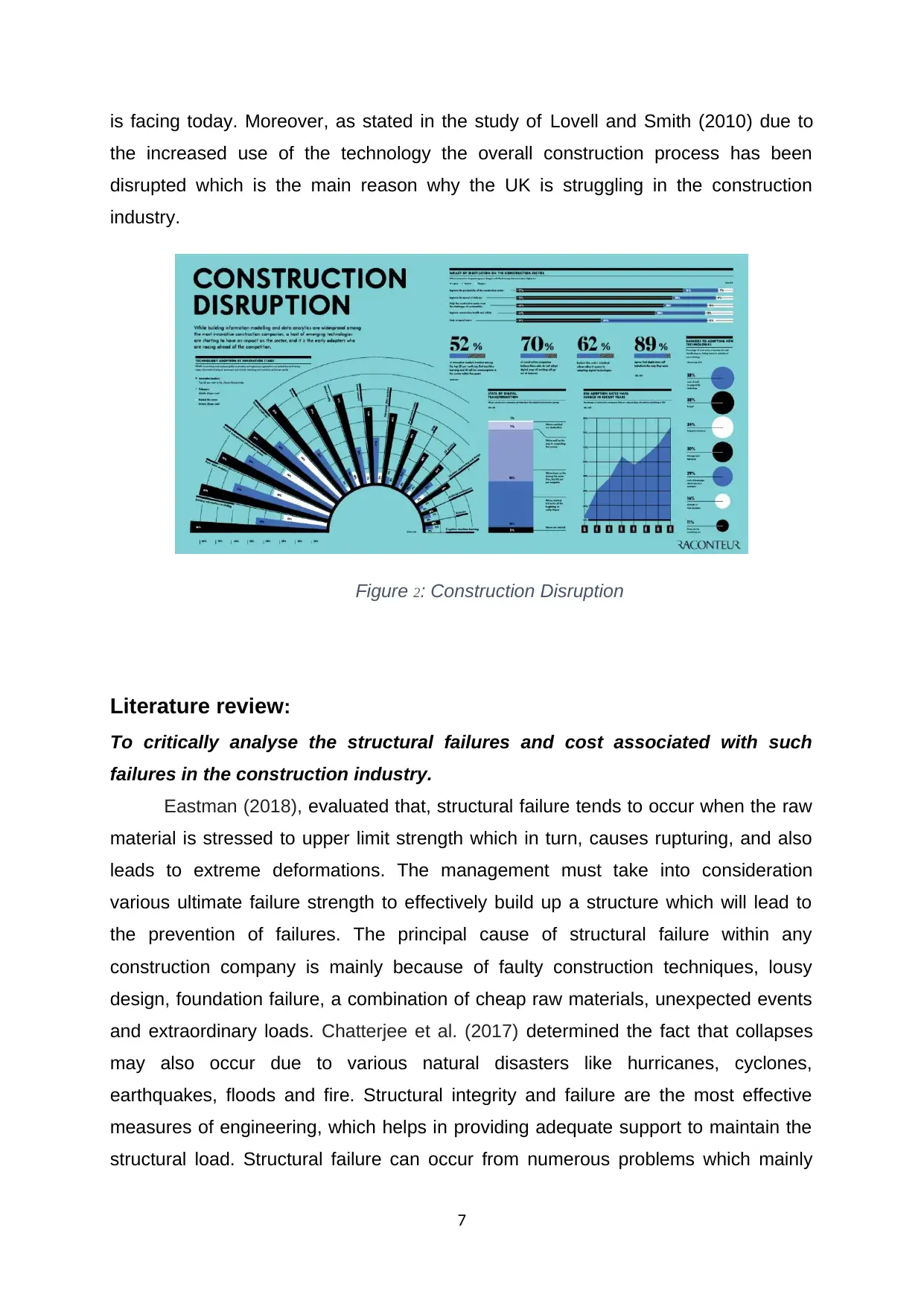
is facing today. Moreover, as stated in the study of Lovell and Smith (2010) due to
the increased use of the technology the overall construction process has been
disrupted which is the main reason why the UK is struggling in the construction
industry.
Figure 2: Construction Disruption
Literature review:
To critically analyse the structural failures and cost associated with such
failures in the construction industry.
Eastman (2018), evaluated that, structural failure tends to occur when the raw
material is stressed to upper limit strength which in turn, causes rupturing, and also
leads to extreme deformations. The management must take into consideration
various ultimate failure strength to effectively build up a structure which will lead to
the prevention of failures. The principal cause of structural failure within any
construction company is mainly because of faulty construction techniques, lousy
design, foundation failure, a combination of cheap raw materials, unexpected events
and extraordinary loads. Chatterjee et al. (2017) determined the fact that collapses
may also occur due to various natural disasters like hurricanes, cyclones,
earthquakes, floods and fire. Structural integrity and failure are the most effective
measures of engineering, which helps in providing adequate support to maintain the
structural load. Structural failure can occur from numerous problems which mainly
7
the increased use of the technology the overall construction process has been
disrupted which is the main reason why the UK is struggling in the construction
industry.
Figure 2: Construction Disruption
Literature review:
To critically analyse the structural failures and cost associated with such
failures in the construction industry.
Eastman (2018), evaluated that, structural failure tends to occur when the raw
material is stressed to upper limit strength which in turn, causes rupturing, and also
leads to extreme deformations. The management must take into consideration
various ultimate failure strength to effectively build up a structure which will lead to
the prevention of failures. The principal cause of structural failure within any
construction company is mainly because of faulty construction techniques, lousy
design, foundation failure, a combination of cheap raw materials, unexpected events
and extraordinary loads. Chatterjee et al. (2017) determined the fact that collapses
may also occur due to various natural disasters like hurricanes, cyclones,
earthquakes, floods and fire. Structural integrity and failure are the most effective
measures of engineering, which helps in providing adequate support to maintain the
structural load. Structural failure can occur from numerous problems which mainly
7
Paraphrase This Document
Need a fresh take? Get an instant paraphrase of this document with our AI Paraphraser
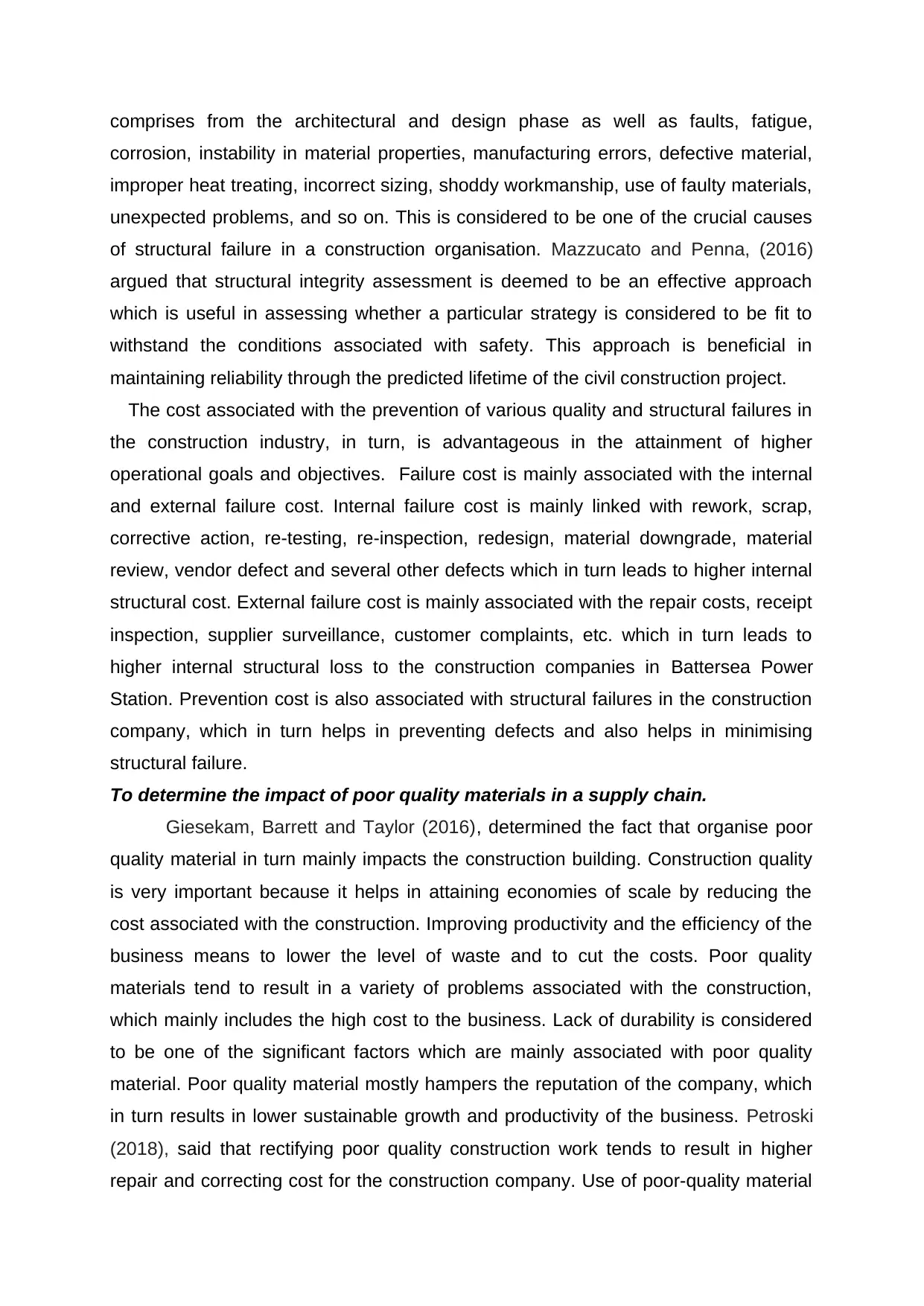
comprises from the architectural and design phase as well as faults, fatigue,
corrosion, instability in material properties, manufacturing errors, defective material,
improper heat treating, incorrect sizing, shoddy workmanship, use of faulty materials,
unexpected problems, and so on. This is considered to be one of the crucial causes
of structural failure in a construction organisation. Mazzucato and Penna, (2016)
argued that structural integrity assessment is deemed to be an effective approach
which is useful in assessing whether a particular strategy is considered to be fit to
withstand the conditions associated with safety. This approach is beneficial in
maintaining reliability through the predicted lifetime of the civil construction project.
The cost associated with the prevention of various quality and structural failures in
the construction industry, in turn, is advantageous in the attainment of higher
operational goals and objectives. Failure cost is mainly associated with the internal
and external failure cost. Internal failure cost is mainly linked with rework, scrap,
corrective action, re-testing, re-inspection, redesign, material downgrade, material
review, vendor defect and several other defects which in turn leads to higher internal
structural cost. External failure cost is mainly associated with the repair costs, receipt
inspection, supplier surveillance, customer complaints, etc. which in turn leads to
higher internal structural loss to the construction companies in Battersea Power
Station. Prevention cost is also associated with structural failures in the construction
company, which in turn helps in preventing defects and also helps in minimising
structural failure.
To determine the impact of poor quality materials in a supply chain.
Giesekam, Barrett and Taylor (2016), determined the fact that organise poor
quality material in turn mainly impacts the construction building. Construction quality
is very important because it helps in attaining economies of scale by reducing the
cost associated with the construction. Improving productivity and the efficiency of the
business means to lower the level of waste and to cut the costs. Poor quality
materials tend to result in a variety of problems associated with the construction,
which mainly includes the high cost to the business. Lack of durability is considered
to be one of the significant factors which are mainly associated with poor quality
material. Poor quality material mostly hampers the reputation of the company, which
in turn results in lower sustainable growth and productivity of the business. Petroski
(2018), said that rectifying poor quality construction work tends to result in higher
repair and correcting cost for the construction company. Use of poor-quality material
corrosion, instability in material properties, manufacturing errors, defective material,
improper heat treating, incorrect sizing, shoddy workmanship, use of faulty materials,
unexpected problems, and so on. This is considered to be one of the crucial causes
of structural failure in a construction organisation. Mazzucato and Penna, (2016)
argued that structural integrity assessment is deemed to be an effective approach
which is useful in assessing whether a particular strategy is considered to be fit to
withstand the conditions associated with safety. This approach is beneficial in
maintaining reliability through the predicted lifetime of the civil construction project.
The cost associated with the prevention of various quality and structural failures in
the construction industry, in turn, is advantageous in the attainment of higher
operational goals and objectives. Failure cost is mainly associated with the internal
and external failure cost. Internal failure cost is mainly linked with rework, scrap,
corrective action, re-testing, re-inspection, redesign, material downgrade, material
review, vendor defect and several other defects which in turn leads to higher internal
structural cost. External failure cost is mainly associated with the repair costs, receipt
inspection, supplier surveillance, customer complaints, etc. which in turn leads to
higher internal structural loss to the construction companies in Battersea Power
Station. Prevention cost is also associated with structural failures in the construction
company, which in turn helps in preventing defects and also helps in minimising
structural failure.
To determine the impact of poor quality materials in a supply chain.
Giesekam, Barrett and Taylor (2016), determined the fact that organise poor
quality material in turn mainly impacts the construction building. Construction quality
is very important because it helps in attaining economies of scale by reducing the
cost associated with the construction. Improving productivity and the efficiency of the
business means to lower the level of waste and to cut the costs. Poor quality
materials tend to result in a variety of problems associated with the construction,
which mainly includes the high cost to the business. Lack of durability is considered
to be one of the significant factors which are mainly associated with poor quality
material. Poor quality material mostly hampers the reputation of the company, which
in turn results in lower sustainable growth and productivity of the business. Petroski
(2018), said that rectifying poor quality construction work tends to result in higher
repair and correcting cost for the construction company. Use of poor-quality material
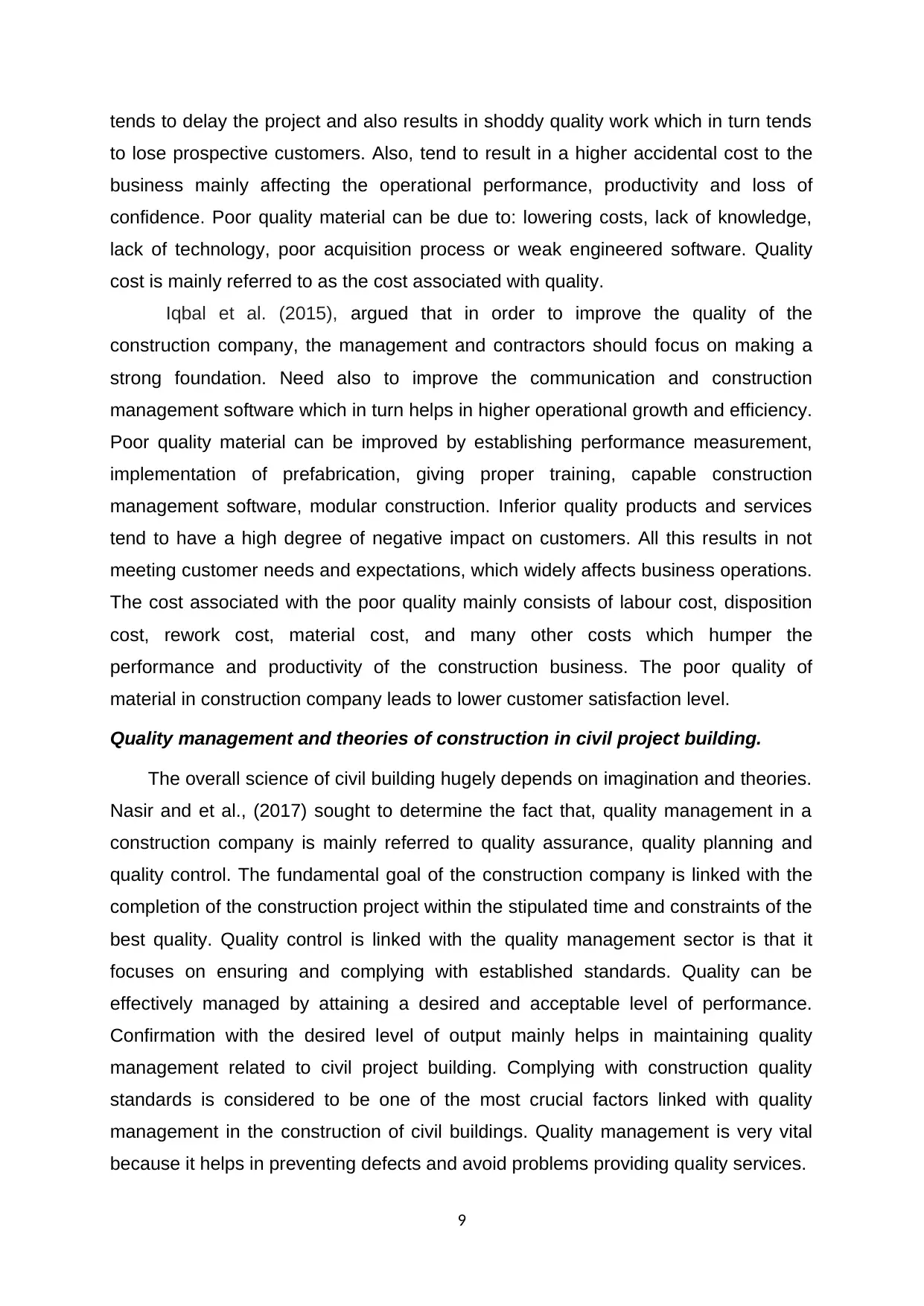
tends to delay the project and also results in shoddy quality work which in turn tends
to lose prospective customers. Also, tend to result in a higher accidental cost to the
business mainly affecting the operational performance, productivity and loss of
confidence. Poor quality material can be due to: lowering costs, lack of knowledge,
lack of technology, poor acquisition process or weak engineered software. Quality
cost is mainly referred to as the cost associated with quality.
Iqbal et al. (2015), argued that in order to improve the quality of the
construction company, the management and contractors should focus on making a
strong foundation. Need also to improve the communication and construction
management software which in turn helps in higher operational growth and efficiency.
Poor quality material can be improved by establishing performance measurement,
implementation of prefabrication, giving proper training, capable construction
management software, modular construction. Inferior quality products and services
tend to have a high degree of negative impact on customers. All this results in not
meeting customer needs and expectations, which widely affects business operations.
The cost associated with the poor quality mainly consists of labour cost, disposition
cost, rework cost, material cost, and many other costs which humper the
performance and productivity of the construction business. The poor quality of
material in construction company leads to lower customer satisfaction level.
Quality management and theories of construction in civil project building.
The overall science of civil building hugely depends on imagination and theories.
Nasir and et al., (2017) sought to determine the fact that, quality management in a
construction company is mainly referred to quality assurance, quality planning and
quality control. The fundamental goal of the construction company is linked with the
completion of the construction project within the stipulated time and constraints of the
best quality. Quality control is linked with the quality management sector is that it
focuses on ensuring and complying with established standards. Quality can be
effectively managed by attaining a desired and acceptable level of performance.
Confirmation with the desired level of output mainly helps in maintaining quality
management related to civil project building. Complying with construction quality
standards is considered to be one of the most crucial factors linked with quality
management in the construction of civil buildings. Quality management is very vital
because it helps in preventing defects and avoid problems providing quality services.
9
to lose prospective customers. Also, tend to result in a higher accidental cost to the
business mainly affecting the operational performance, productivity and loss of
confidence. Poor quality material can be due to: lowering costs, lack of knowledge,
lack of technology, poor acquisition process or weak engineered software. Quality
cost is mainly referred to as the cost associated with quality.
Iqbal et al. (2015), argued that in order to improve the quality of the
construction company, the management and contractors should focus on making a
strong foundation. Need also to improve the communication and construction
management software which in turn helps in higher operational growth and efficiency.
Poor quality material can be improved by establishing performance measurement,
implementation of prefabrication, giving proper training, capable construction
management software, modular construction. Inferior quality products and services
tend to have a high degree of negative impact on customers. All this results in not
meeting customer needs and expectations, which widely affects business operations.
The cost associated with the poor quality mainly consists of labour cost, disposition
cost, rework cost, material cost, and many other costs which humper the
performance and productivity of the construction business. The poor quality of
material in construction company leads to lower customer satisfaction level.
Quality management and theories of construction in civil project building.
The overall science of civil building hugely depends on imagination and theories.
Nasir and et al., (2017) sought to determine the fact that, quality management in a
construction company is mainly referred to quality assurance, quality planning and
quality control. The fundamental goal of the construction company is linked with the
completion of the construction project within the stipulated time and constraints of the
best quality. Quality control is linked with the quality management sector is that it
focuses on ensuring and complying with established standards. Quality can be
effectively managed by attaining a desired and acceptable level of performance.
Confirmation with the desired level of output mainly helps in maintaining quality
management related to civil project building. Complying with construction quality
standards is considered to be one of the most crucial factors linked with quality
management in the construction of civil buildings. Quality management is very vital
because it helps in preventing defects and avoid problems providing quality services.
9
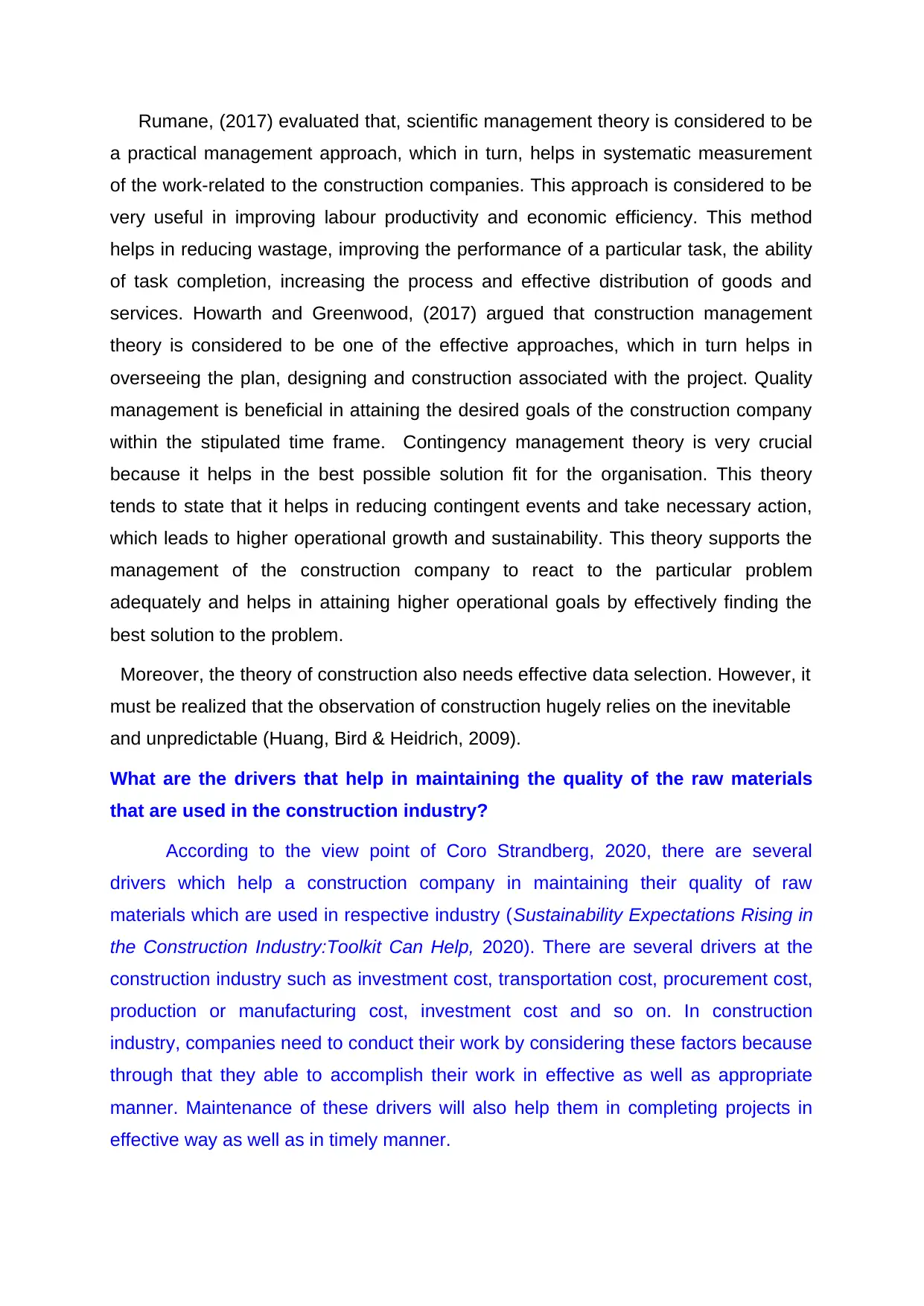
Rumane, (2017) evaluated that, scientific management theory is considered to be
a practical management approach, which in turn, helps in systematic measurement
of the work-related to the construction companies. This approach is considered to be
very useful in improving labour productivity and economic efficiency. This method
helps in reducing wastage, improving the performance of a particular task, the ability
of task completion, increasing the process and effective distribution of goods and
services. Howarth and Greenwood, (2017) argued that construction management
theory is considered to be one of the effective approaches, which in turn helps in
overseeing the plan, designing and construction associated with the project. Quality
management is beneficial in attaining the desired goals of the construction company
within the stipulated time frame. Contingency management theory is very crucial
because it helps in the best possible solution fit for the organisation. This theory
tends to state that it helps in reducing contingent events and take necessary action,
which leads to higher operational growth and sustainability. This theory supports the
management of the construction company to react to the particular problem
adequately and helps in attaining higher operational goals by effectively finding the
best solution to the problem.
Moreover, the theory of construction also needs effective data selection. However, it
must be realized that the observation of construction hugely relies on the inevitable
and unpredictable (Huang, Bird & Heidrich, 2009).
What are the drivers that help in maintaining the quality of the raw materials
that are used in the construction industry?
According to the view point of Coro Strandberg, 2020, there are several
drivers which help a construction company in maintaining their quality of raw
materials which are used in respective industry (Sustainability Expectations Rising in
the Construction Industry:Toolkit Can Help, 2020). There are several drivers at the
construction industry such as investment cost, transportation cost, procurement cost,
production or manufacturing cost, investment cost and so on. In construction
industry, companies need to conduct their work by considering these factors because
through that they able to accomplish their work in effective as well as appropriate
manner. Maintenance of these drivers will also help them in completing projects in
effective way as well as in timely manner.
a practical management approach, which in turn, helps in systematic measurement
of the work-related to the construction companies. This approach is considered to be
very useful in improving labour productivity and economic efficiency. This method
helps in reducing wastage, improving the performance of a particular task, the ability
of task completion, increasing the process and effective distribution of goods and
services. Howarth and Greenwood, (2017) argued that construction management
theory is considered to be one of the effective approaches, which in turn helps in
overseeing the plan, designing and construction associated with the project. Quality
management is beneficial in attaining the desired goals of the construction company
within the stipulated time frame. Contingency management theory is very crucial
because it helps in the best possible solution fit for the organisation. This theory
tends to state that it helps in reducing contingent events and take necessary action,
which leads to higher operational growth and sustainability. This theory supports the
management of the construction company to react to the particular problem
adequately and helps in attaining higher operational goals by effectively finding the
best solution to the problem.
Moreover, the theory of construction also needs effective data selection. However, it
must be realized that the observation of construction hugely relies on the inevitable
and unpredictable (Huang, Bird & Heidrich, 2009).
What are the drivers that help in maintaining the quality of the raw materials
that are used in the construction industry?
According to the view point of Coro Strandberg, 2020, there are several
drivers which help a construction company in maintaining their quality of raw
materials which are used in respective industry (Sustainability Expectations Rising in
the Construction Industry:Toolkit Can Help, 2020). There are several drivers at the
construction industry such as investment cost, transportation cost, procurement cost,
production or manufacturing cost, investment cost and so on. In construction
industry, companies need to conduct their work by considering these factors because
through that they able to accomplish their work in effective as well as appropriate
manner. Maintenance of these drivers will also help them in completing projects in
effective way as well as in timely manner.
Secure Best Marks with AI Grader
Need help grading? Try our AI Grader for instant feedback on your assignments.
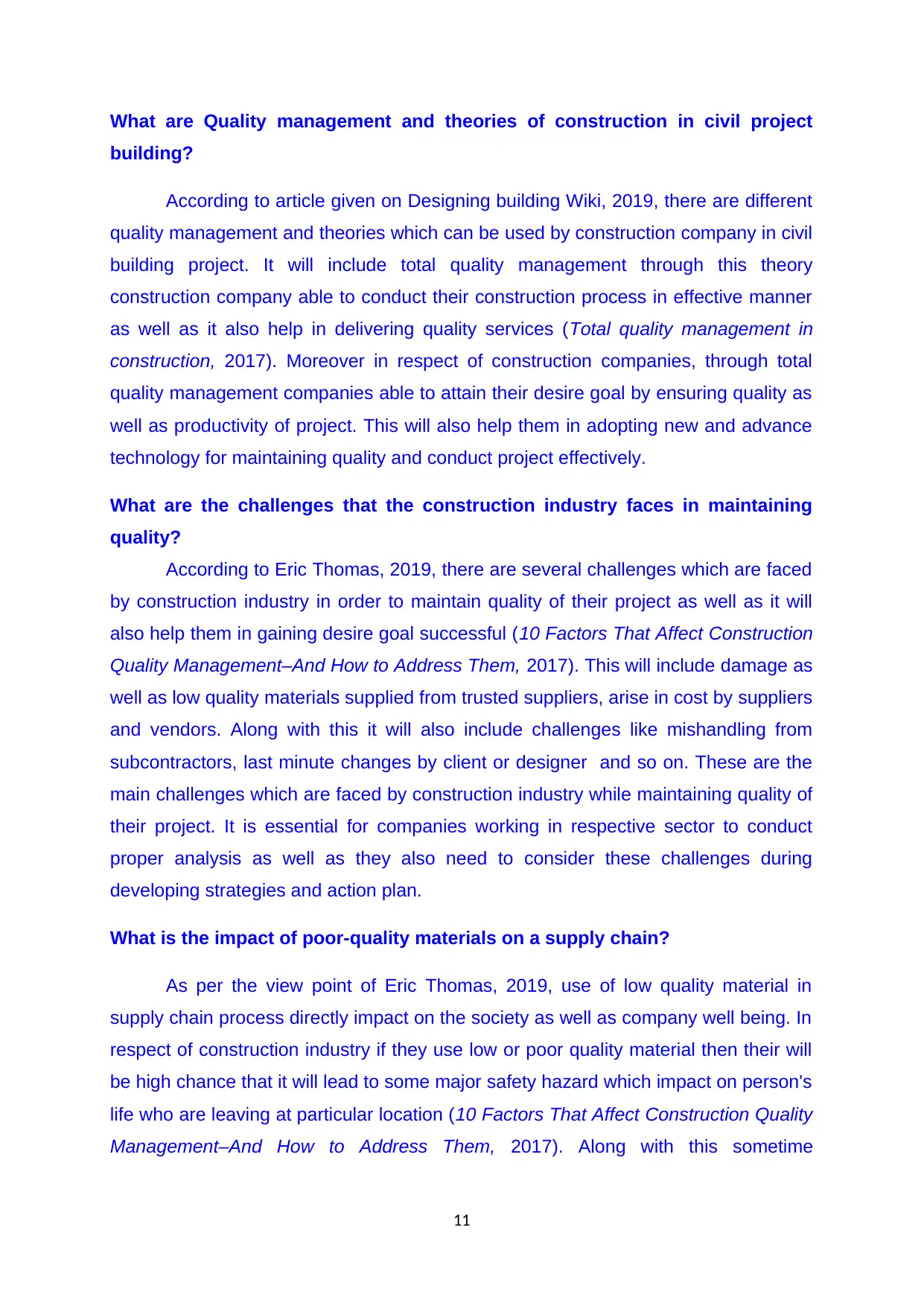
What are Quality management and theories of construction in civil project
building?
According to article given on Designing building Wiki, 2019, there are different
quality management and theories which can be used by construction company in civil
building project. It will include total quality management through this theory
construction company able to conduct their construction process in effective manner
as well as it also help in delivering quality services (Total quality management in
construction, 2017). Moreover in respect of construction companies, through total
quality management companies able to attain their desire goal by ensuring quality as
well as productivity of project. This will also help them in adopting new and advance
technology for maintaining quality and conduct project effectively.
What are the challenges that the construction industry faces in maintaining
quality?
According to Eric Thomas, 2019, there are several challenges which are faced
by construction industry in order to maintain quality of their project as well as it will
also help them in gaining desire goal successful (10 Factors That Affect Construction
Quality Management–And How to Address Them, 2017). This will include damage as
well as low quality materials supplied from trusted suppliers, arise in cost by suppliers
and vendors. Along with this it will also include challenges like mishandling from
subcontractors, last minute changes by client or designer and so on. These are the
main challenges which are faced by construction industry while maintaining quality of
their project. It is essential for companies working in respective sector to conduct
proper analysis as well as they also need to consider these challenges during
developing strategies and action plan.
What is the impact of poor-quality materials on a supply chain?
As per the view point of Eric Thomas, 2019, use of low quality material in
supply chain process directly impact on the society as well as company well being. In
respect of construction industry if they use low or poor quality material then their will
be high chance that it will lead to some major safety hazard which impact on person's
life who are leaving at particular location (10 Factors That Affect Construction Quality
Management–And How to Address Them, 2017). Along with this sometime
11
building?
According to article given on Designing building Wiki, 2019, there are different
quality management and theories which can be used by construction company in civil
building project. It will include total quality management through this theory
construction company able to conduct their construction process in effective manner
as well as it also help in delivering quality services (Total quality management in
construction, 2017). Moreover in respect of construction companies, through total
quality management companies able to attain their desire goal by ensuring quality as
well as productivity of project. This will also help them in adopting new and advance
technology for maintaining quality and conduct project effectively.
What are the challenges that the construction industry faces in maintaining
quality?
According to Eric Thomas, 2019, there are several challenges which are faced
by construction industry in order to maintain quality of their project as well as it will
also help them in gaining desire goal successful (10 Factors That Affect Construction
Quality Management–And How to Address Them, 2017). This will include damage as
well as low quality materials supplied from trusted suppliers, arise in cost by suppliers
and vendors. Along with this it will also include challenges like mishandling from
subcontractors, last minute changes by client or designer and so on. These are the
main challenges which are faced by construction industry while maintaining quality of
their project. It is essential for companies working in respective sector to conduct
proper analysis as well as they also need to consider these challenges during
developing strategies and action plan.
What is the impact of poor-quality materials on a supply chain?
As per the view point of Eric Thomas, 2019, use of low quality material in
supply chain process directly impact on the society as well as company well being. In
respect of construction industry if they use low or poor quality material then their will
be high chance that it will lead to some major safety hazard which impact on person's
life who are leaving at particular location (10 Factors That Affect Construction Quality
Management–And How to Address Them, 2017). Along with this sometime
11
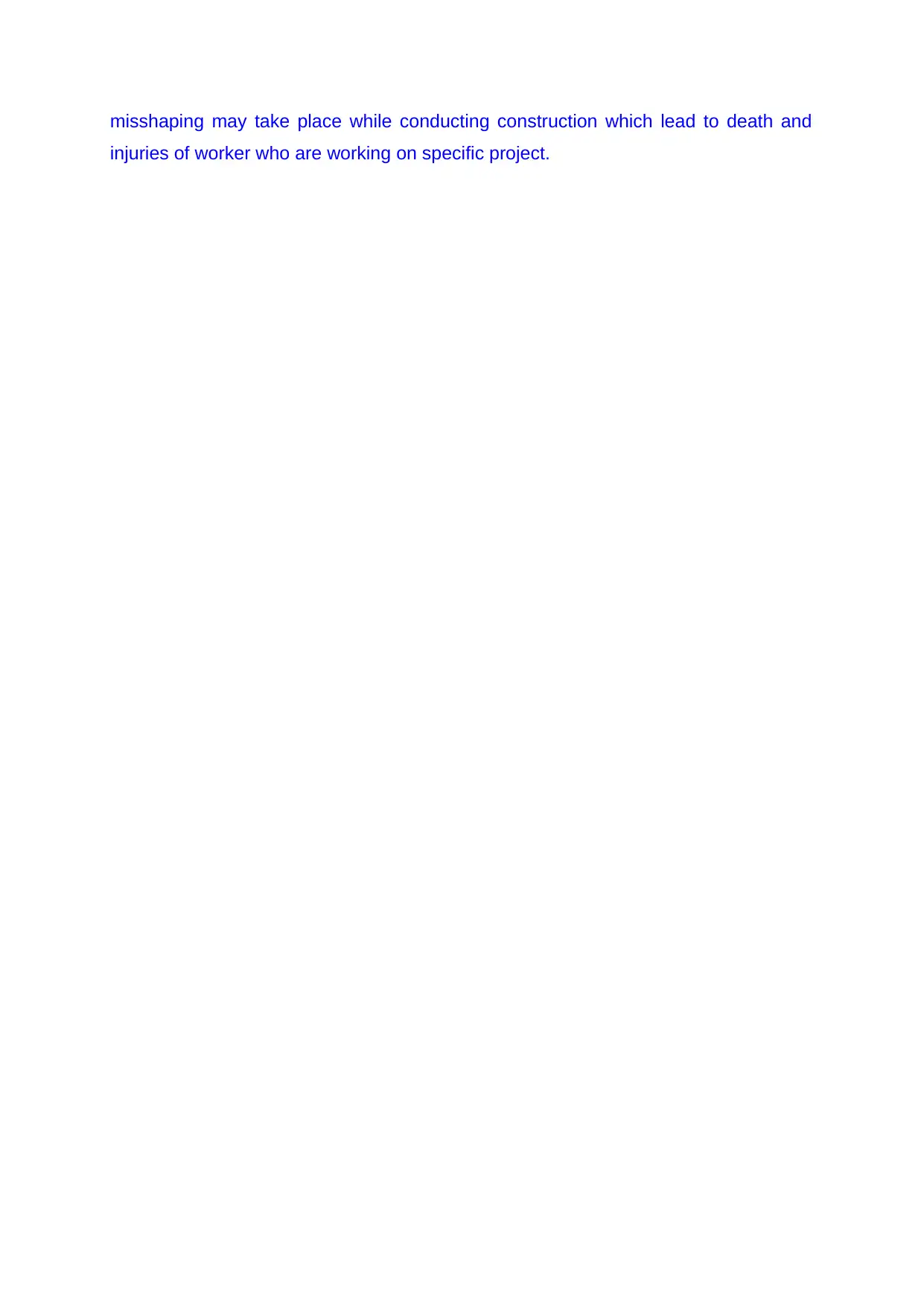
misshaping may take place while conducting construction which lead to death and
injuries of worker who are working on specific project.
injuries of worker who are working on specific project.
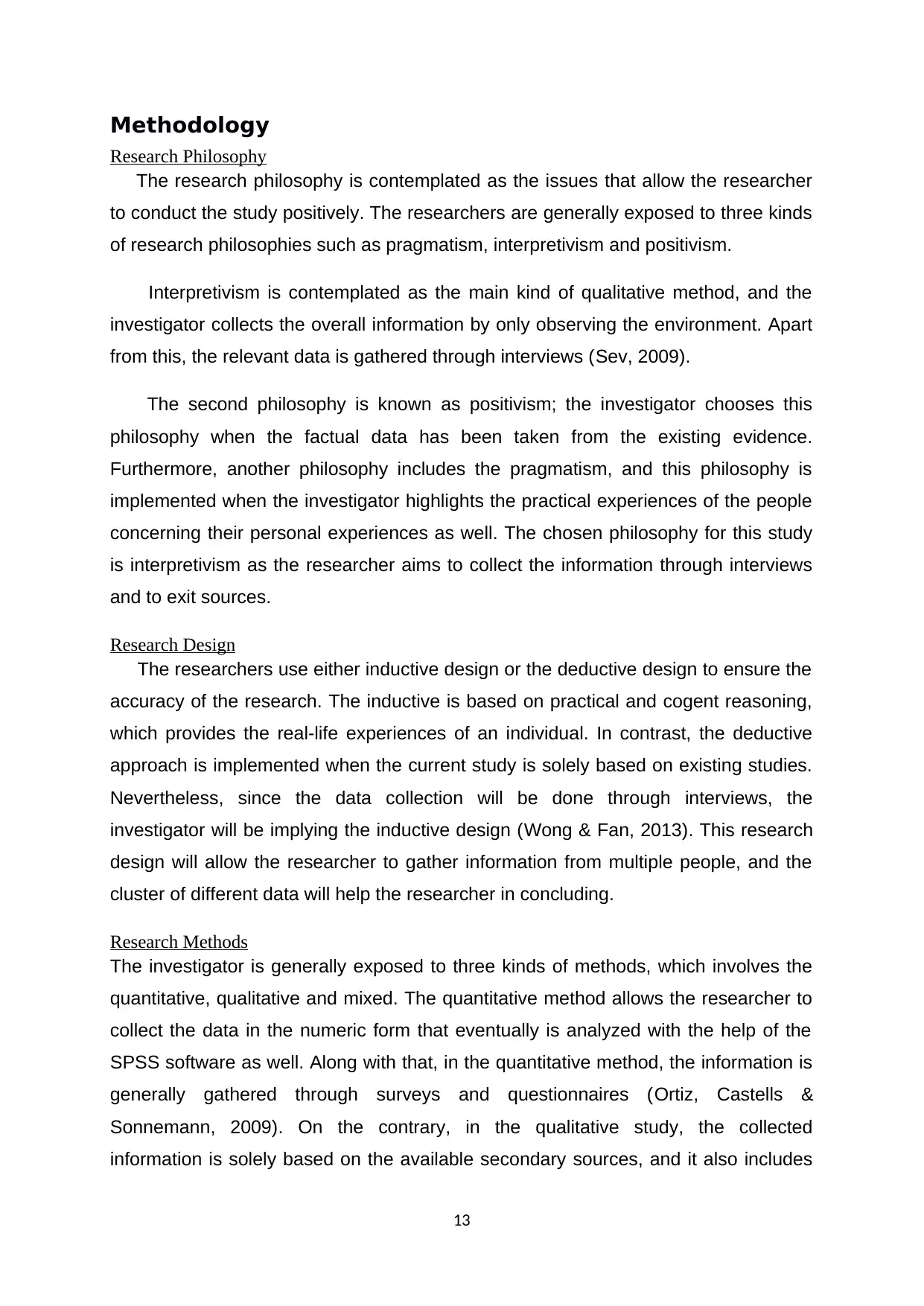
Methodology
Research Philosophy
The research philosophy is contemplated as the issues that allow the researcher
to conduct the study positively. The researchers are generally exposed to three kinds
of research philosophies such as pragmatism, interpretivism and positivism.
Interpretivism is contemplated as the main kind of qualitative method, and the
investigator collects the overall information by only observing the environment. Apart
from this, the relevant data is gathered through interviews (Sev, 2009).
The second philosophy is known as positivism; the investigator chooses this
philosophy when the factual data has been taken from the existing evidence.
Furthermore, another philosophy includes the pragmatism, and this philosophy is
implemented when the investigator highlights the practical experiences of the people
concerning their personal experiences as well. The chosen philosophy for this study
is interpretivism as the researcher aims to collect the information through interviews
and to exit sources.
Research Design
The researchers use either inductive design or the deductive design to ensure the
accuracy of the research. The inductive is based on practical and cogent reasoning,
which provides the real-life experiences of an individual. In contrast, the deductive
approach is implemented when the current study is solely based on existing studies.
Nevertheless, since the data collection will be done through interviews, the
investigator will be implying the inductive design (Wong & Fan, 2013). This research
design will allow the researcher to gather information from multiple people, and the
cluster of different data will help the researcher in concluding.
Research Methods
The investigator is generally exposed to three kinds of methods, which involves the
quantitative, qualitative and mixed. The quantitative method allows the researcher to
collect the data in the numeric form that eventually is analyzed with the help of the
SPSS software as well. Along with that, in the quantitative method, the information is
generally gathered through surveys and questionnaires (Ortiz, Castells &
Sonnemann, 2009). On the contrary, in the qualitative study, the collected
information is solely based on the available secondary sources, and it also includes
13
Research Philosophy
The research philosophy is contemplated as the issues that allow the researcher
to conduct the study positively. The researchers are generally exposed to three kinds
of research philosophies such as pragmatism, interpretivism and positivism.
Interpretivism is contemplated as the main kind of qualitative method, and the
investigator collects the overall information by only observing the environment. Apart
from this, the relevant data is gathered through interviews (Sev, 2009).
The second philosophy is known as positivism; the investigator chooses this
philosophy when the factual data has been taken from the existing evidence.
Furthermore, another philosophy includes the pragmatism, and this philosophy is
implemented when the investigator highlights the practical experiences of the people
concerning their personal experiences as well. The chosen philosophy for this study
is interpretivism as the researcher aims to collect the information through interviews
and to exit sources.
Research Design
The researchers use either inductive design or the deductive design to ensure the
accuracy of the research. The inductive is based on practical and cogent reasoning,
which provides the real-life experiences of an individual. In contrast, the deductive
approach is implemented when the current study is solely based on existing studies.
Nevertheless, since the data collection will be done through interviews, the
investigator will be implying the inductive design (Wong & Fan, 2013). This research
design will allow the researcher to gather information from multiple people, and the
cluster of different data will help the researcher in concluding.
Research Methods
The investigator is generally exposed to three kinds of methods, which involves the
quantitative, qualitative and mixed. The quantitative method allows the researcher to
collect the data in the numeric form that eventually is analyzed with the help of the
SPSS software as well. Along with that, in the quantitative method, the information is
generally gathered through surveys and questionnaires (Ortiz, Castells &
Sonnemann, 2009). On the contrary, in the qualitative study, the collected
information is solely based on the available secondary sources, and it also includes
13
Paraphrase This Document
Need a fresh take? Get an instant paraphrase of this document with our AI Paraphraser
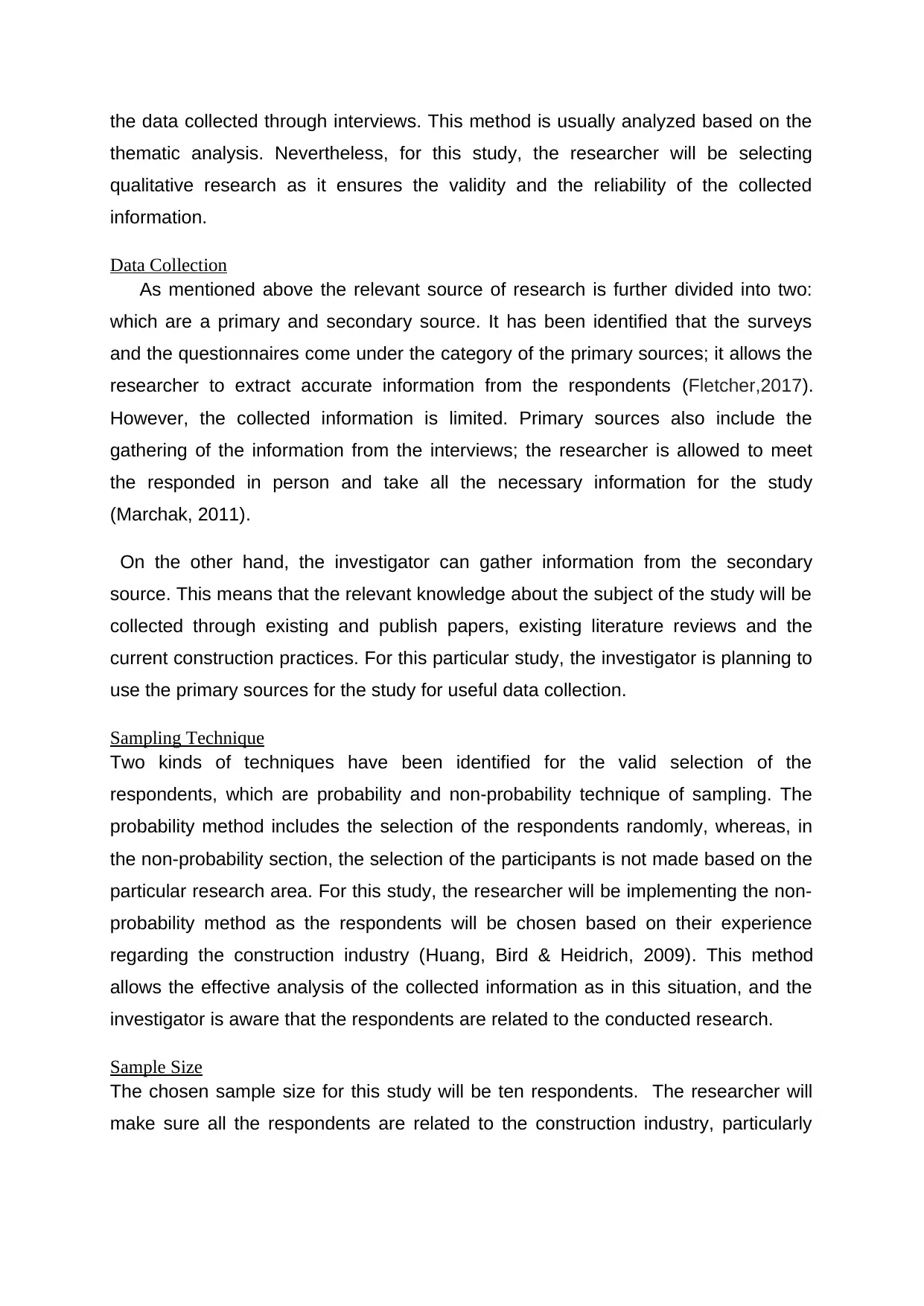
the data collected through interviews. This method is usually analyzed based on the
thematic analysis. Nevertheless, for this study, the researcher will be selecting
qualitative research as it ensures the validity and the reliability of the collected
information.
Data Collection
As mentioned above the relevant source of research is further divided into two:
which are a primary and secondary source. It has been identified that the surveys
and the questionnaires come under the category of the primary sources; it allows the
researcher to extract accurate information from the respondents (Fletcher,2017).
However, the collected information is limited. Primary sources also include the
gathering of the information from the interviews; the researcher is allowed to meet
the responded in person and take all the necessary information for the study
(Marchak, 2011).
On the other hand, the investigator can gather information from the secondary
source. This means that the relevant knowledge about the subject of the study will be
collected through existing and publish papers, existing literature reviews and the
current construction practices. For this particular study, the investigator is planning to
use the primary sources for the study for useful data collection.
Sampling Technique
Two kinds of techniques have been identified for the valid selection of the
respondents, which are probability and non-probability technique of sampling. The
probability method includes the selection of the respondents randomly, whereas, in
the non-probability section, the selection of the participants is not made based on the
particular research area. For this study, the researcher will be implementing the non-
probability method as the respondents will be chosen based on their experience
regarding the construction industry (Huang, Bird & Heidrich, 2009). This method
allows the effective analysis of the collected information as in this situation, and the
investigator is aware that the respondents are related to the conducted research.
Sample Size
The chosen sample size for this study will be ten respondents. The researcher will
make sure all the respondents are related to the construction industry, particularly
thematic analysis. Nevertheless, for this study, the researcher will be selecting
qualitative research as it ensures the validity and the reliability of the collected
information.
Data Collection
As mentioned above the relevant source of research is further divided into two:
which are a primary and secondary source. It has been identified that the surveys
and the questionnaires come under the category of the primary sources; it allows the
researcher to extract accurate information from the respondents (Fletcher,2017).
However, the collected information is limited. Primary sources also include the
gathering of the information from the interviews; the researcher is allowed to meet
the responded in person and take all the necessary information for the study
(Marchak, 2011).
On the other hand, the investigator can gather information from the secondary
source. This means that the relevant knowledge about the subject of the study will be
collected through existing and publish papers, existing literature reviews and the
current construction practices. For this particular study, the investigator is planning to
use the primary sources for the study for useful data collection.
Sampling Technique
Two kinds of techniques have been identified for the valid selection of the
respondents, which are probability and non-probability technique of sampling. The
probability method includes the selection of the respondents randomly, whereas, in
the non-probability section, the selection of the participants is not made based on the
particular research area. For this study, the researcher will be implementing the non-
probability method as the respondents will be chosen based on their experience
regarding the construction industry (Huang, Bird & Heidrich, 2009). This method
allows the effective analysis of the collected information as in this situation, and the
investigator is aware that the respondents are related to the conducted research.
Sample Size
The chosen sample size for this study will be ten respondents. The researcher will
make sure all the respondents are related to the construction industry, particularly
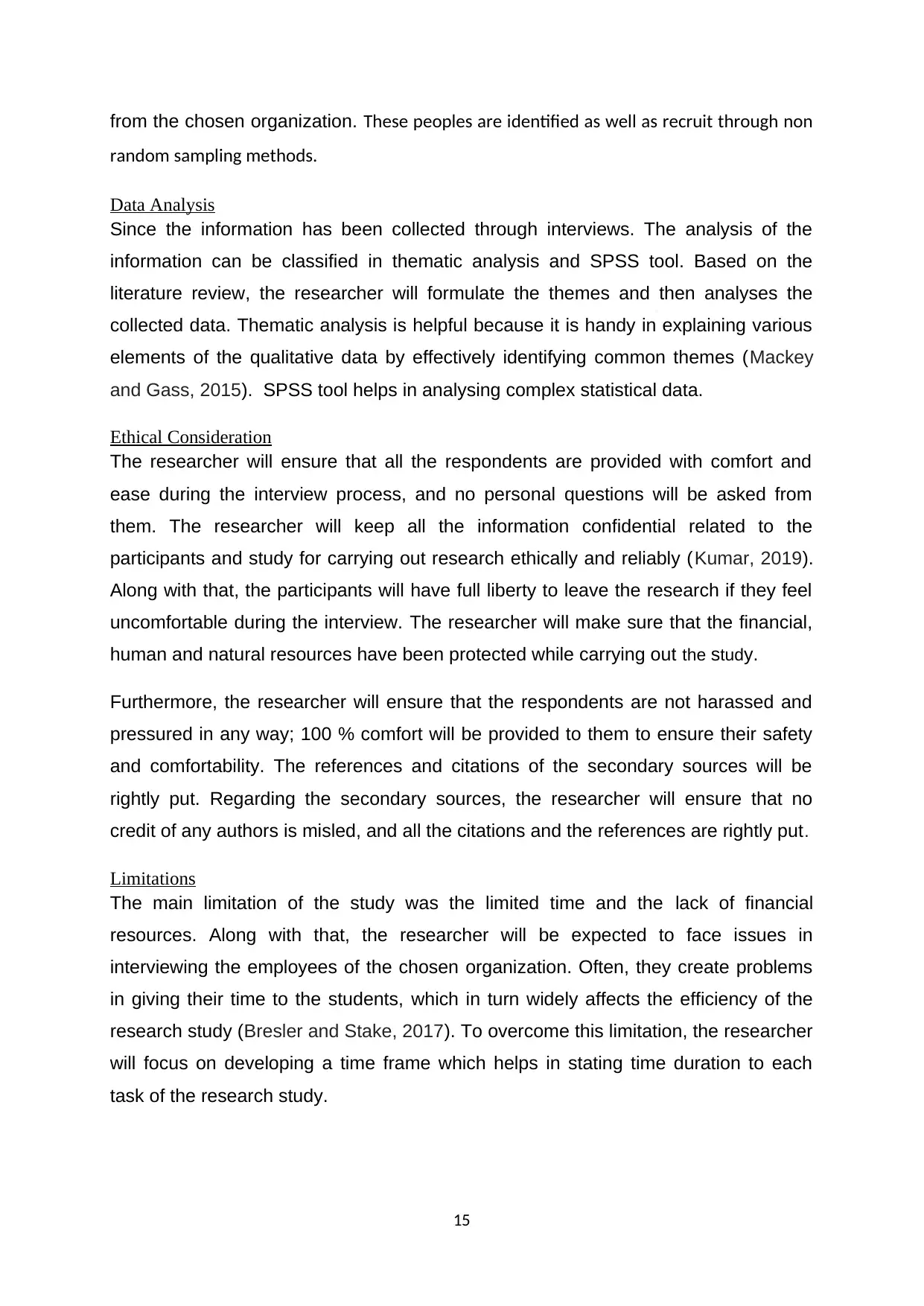
from the chosen organization. These peoples are identified as well as recruit through non
random sampling methods.
Data Analysis
Since the information has been collected through interviews. The analysis of the
information can be classified in thematic analysis and SPSS tool. Based on the
literature review, the researcher will formulate the themes and then analyses the
collected data. Thematic analysis is helpful because it is handy in explaining various
elements of the qualitative data by effectively identifying common themes (Mackey
and Gass, 2015). SPSS tool helps in analysing complex statistical data.
Ethical Consideration
The researcher will ensure that all the respondents are provided with comfort and
ease during the interview process, and no personal questions will be asked from
them. The researcher will keep all the information confidential related to the
participants and study for carrying out research ethically and reliably (Kumar, 2019).
Along with that, the participants will have full liberty to leave the research if they feel
uncomfortable during the interview. The researcher will make sure that the financial,
human and natural resources have been protected while carrying out the study.
Furthermore, the researcher will ensure that the respondents are not harassed and
pressured in any way; 100 % comfort will be provided to them to ensure their safety
and comfortability. The references and citations of the secondary sources will be
rightly put. Regarding the secondary sources, the researcher will ensure that no
credit of any authors is misled, and all the citations and the references are rightly put.
Limitations
The main limitation of the study was the limited time and the lack of financial
resources. Along with that, the researcher will be expected to face issues in
interviewing the employees of the chosen organization. Often, they create problems
in giving their time to the students, which in turn widely affects the efficiency of the
research study (Bresler and Stake, 2017). To overcome this limitation, the researcher
will focus on developing a time frame which helps in stating time duration to each
task of the research study.
15
random sampling methods.
Data Analysis
Since the information has been collected through interviews. The analysis of the
information can be classified in thematic analysis and SPSS tool. Based on the
literature review, the researcher will formulate the themes and then analyses the
collected data. Thematic analysis is helpful because it is handy in explaining various
elements of the qualitative data by effectively identifying common themes (Mackey
and Gass, 2015). SPSS tool helps in analysing complex statistical data.
Ethical Consideration
The researcher will ensure that all the respondents are provided with comfort and
ease during the interview process, and no personal questions will be asked from
them. The researcher will keep all the information confidential related to the
participants and study for carrying out research ethically and reliably (Kumar, 2019).
Along with that, the participants will have full liberty to leave the research if they feel
uncomfortable during the interview. The researcher will make sure that the financial,
human and natural resources have been protected while carrying out the study.
Furthermore, the researcher will ensure that the respondents are not harassed and
pressured in any way; 100 % comfort will be provided to them to ensure their safety
and comfortability. The references and citations of the secondary sources will be
rightly put. Regarding the secondary sources, the researcher will ensure that no
credit of any authors is misled, and all the citations and the references are rightly put.
Limitations
The main limitation of the study was the limited time and the lack of financial
resources. Along with that, the researcher will be expected to face issues in
interviewing the employees of the chosen organization. Often, they create problems
in giving their time to the students, which in turn widely affects the efficiency of the
research study (Bresler and Stake, 2017). To overcome this limitation, the researcher
will focus on developing a time frame which helps in stating time duration to each
task of the research study.
15
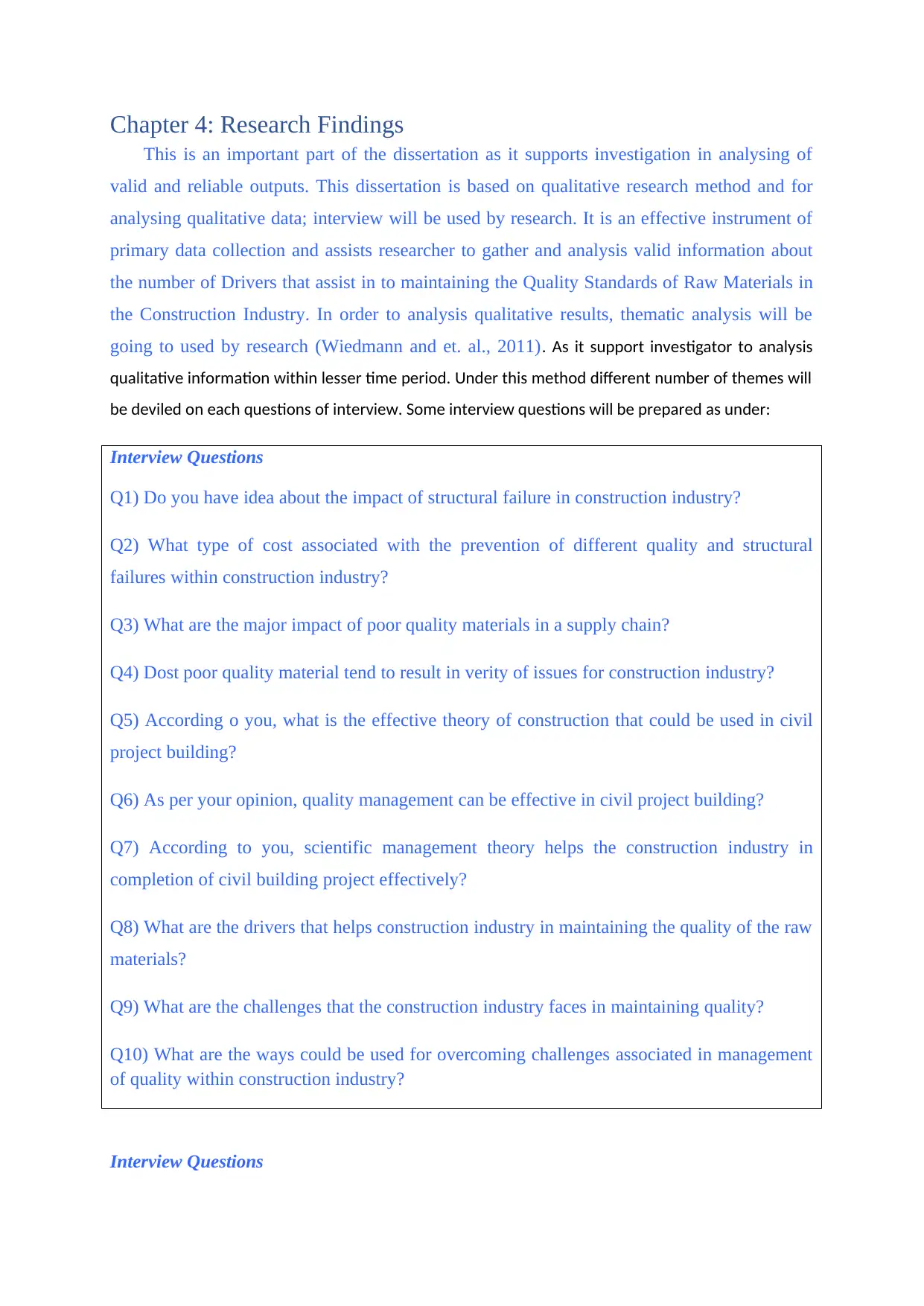
Chapter 4: Research Findings
This is an important part of the dissertation as it supports investigation in analysing of
valid and reliable outputs. This dissertation is based on qualitative research method and for
analysing qualitative data; interview will be used by research. It is an effective instrument of
primary data collection and assists researcher to gather and analysis valid information about
the number of Drivers that assist in to maintaining the Quality Standards of Raw Materials in
the Construction Industry. In order to analysis qualitative results, thematic analysis will be
going to used by research (Wiedmann and et. al., 2011). As it support investigator to analysis
qualitative information within lesser time period. Under this method different number of themes will
be deviled on each questions of interview. Some interview questions will be prepared as under:
Interview Questions
Q1) Do you have idea about the impact of structural failure in construction industry?
Q2) What type of cost associated with the prevention of different quality and structural
failures within construction industry?
Q3) What are the major impact of poor quality materials in a supply chain?
Q4) Dost poor quality material tend to result in verity of issues for construction industry?
Q5) According o you, what is the effective theory of construction that could be used in civil
project building?
Q6) As per your opinion, quality management can be effective in civil project building?
Q7) According to you, scientific management theory helps the construction industry in
completion of civil building project effectively?
Q8) What are the drivers that helps construction industry in maintaining the quality of the raw
materials?
Q9) What are the challenges that the construction industry faces in maintaining quality?
Q10) What are the ways could be used for overcoming challenges associated in management
of quality within construction industry?
Interview Questions
This is an important part of the dissertation as it supports investigation in analysing of
valid and reliable outputs. This dissertation is based on qualitative research method and for
analysing qualitative data; interview will be used by research. It is an effective instrument of
primary data collection and assists researcher to gather and analysis valid information about
the number of Drivers that assist in to maintaining the Quality Standards of Raw Materials in
the Construction Industry. In order to analysis qualitative results, thematic analysis will be
going to used by research (Wiedmann and et. al., 2011). As it support investigator to analysis
qualitative information within lesser time period. Under this method different number of themes will
be deviled on each questions of interview. Some interview questions will be prepared as under:
Interview Questions
Q1) Do you have idea about the impact of structural failure in construction industry?
Q2) What type of cost associated with the prevention of different quality and structural
failures within construction industry?
Q3) What are the major impact of poor quality materials in a supply chain?
Q4) Dost poor quality material tend to result in verity of issues for construction industry?
Q5) According o you, what is the effective theory of construction that could be used in civil
project building?
Q6) As per your opinion, quality management can be effective in civil project building?
Q7) According to you, scientific management theory helps the construction industry in
completion of civil building project effectively?
Q8) What are the drivers that helps construction industry in maintaining the quality of the raw
materials?
Q9) What are the challenges that the construction industry faces in maintaining quality?
Q10) What are the ways could be used for overcoming challenges associated in management
of quality within construction industry?
Interview Questions
Secure Best Marks with AI Grader
Need help grading? Try our AI Grader for instant feedback on your assignments.
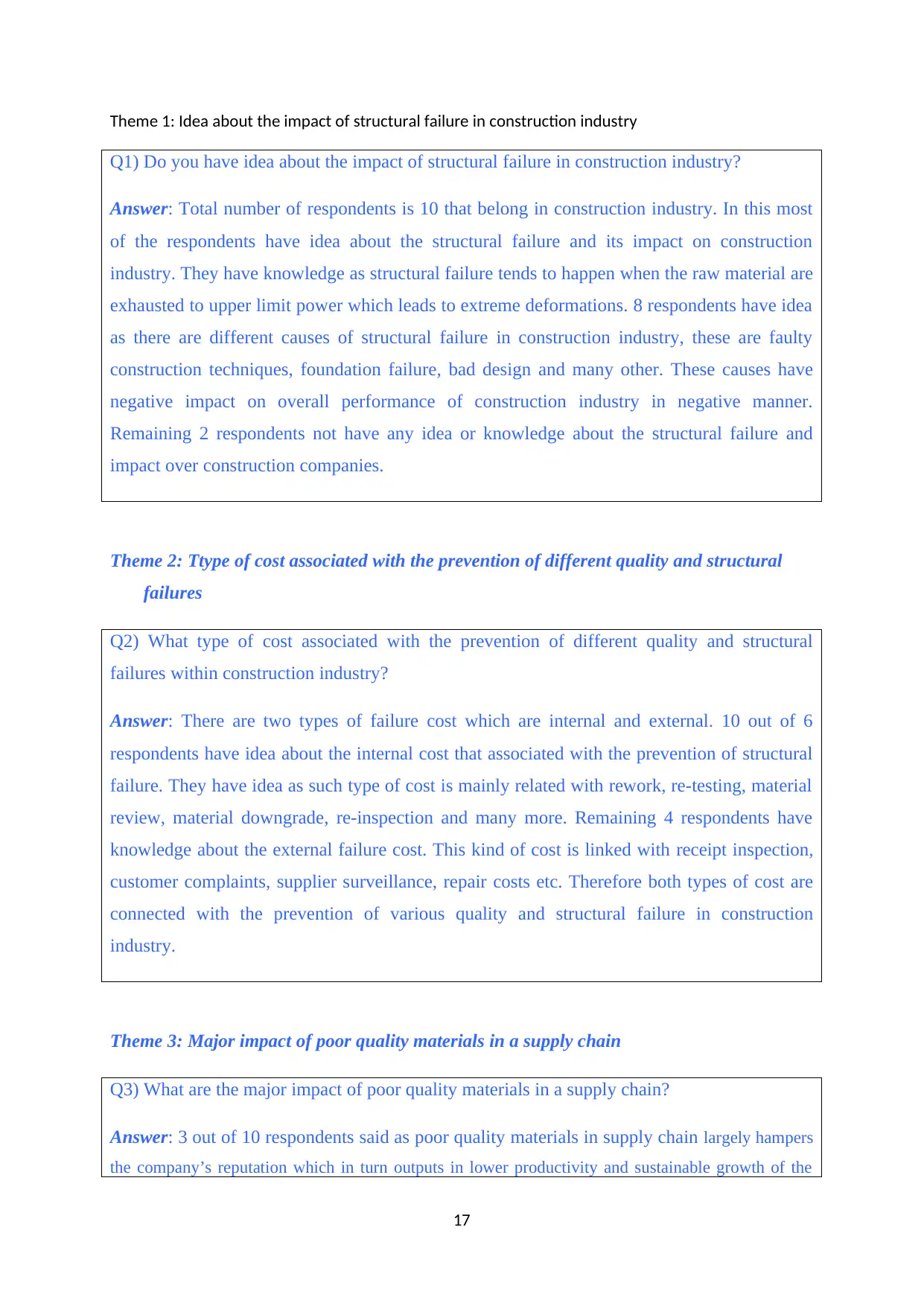
Theme 1: Idea about the impact of structural failure in construction industry
Q1) Do you have idea about the impact of structural failure in construction industry?
Answer: Total number of respondents is 10 that belong in construction industry. In this most
of the respondents have idea about the structural failure and its impact on construction
industry. They have knowledge as structural failure tends to happen when the raw material are
exhausted to upper limit power which leads to extreme deformations. 8 respondents have idea
as there are different causes of structural failure in construction industry, these are faulty
construction techniques, foundation failure, bad design and many other. These causes have
negative impact on overall performance of construction industry in negative manner.
Remaining 2 respondents not have any idea or knowledge about the structural failure and
impact over construction companies.
Theme 2: Ttype of cost associated with the prevention of different quality and structural
failures
Q2) What type of cost associated with the prevention of different quality and structural
failures within construction industry?
Answer: There are two types of failure cost which are internal and external. 10 out of 6
respondents have idea about the internal cost that associated with the prevention of structural
failure. They have idea as such type of cost is mainly related with rework, re-testing, material
review, material downgrade, re-inspection and many more. Remaining 4 respondents have
knowledge about the external failure cost. This kind of cost is linked with receipt inspection,
customer complaints, supplier surveillance, repair costs etc. Therefore both types of cost are
connected with the prevention of various quality and structural failure in construction
industry.
Theme 3: Major impact of poor quality materials in a supply chain
Q3) What are the major impact of poor quality materials in a supply chain?
Answer: 3 out of 10 respondents said as poor quality materials in supply chain largely hampers
the company’s reputation which in turn outputs in lower productivity and sustainable growth of the
17
Q1) Do you have idea about the impact of structural failure in construction industry?
Answer: Total number of respondents is 10 that belong in construction industry. In this most
of the respondents have idea about the structural failure and its impact on construction
industry. They have knowledge as structural failure tends to happen when the raw material are
exhausted to upper limit power which leads to extreme deformations. 8 respondents have idea
as there are different causes of structural failure in construction industry, these are faulty
construction techniques, foundation failure, bad design and many other. These causes have
negative impact on overall performance of construction industry in negative manner.
Remaining 2 respondents not have any idea or knowledge about the structural failure and
impact over construction companies.
Theme 2: Ttype of cost associated with the prevention of different quality and structural
failures
Q2) What type of cost associated with the prevention of different quality and structural
failures within construction industry?
Answer: There are two types of failure cost which are internal and external. 10 out of 6
respondents have idea about the internal cost that associated with the prevention of structural
failure. They have idea as such type of cost is mainly related with rework, re-testing, material
review, material downgrade, re-inspection and many more. Remaining 4 respondents have
knowledge about the external failure cost. This kind of cost is linked with receipt inspection,
customer complaints, supplier surveillance, repair costs etc. Therefore both types of cost are
connected with the prevention of various quality and structural failure in construction
industry.
Theme 3: Major impact of poor quality materials in a supply chain
Q3) What are the major impact of poor quality materials in a supply chain?
Answer: 3 out of 10 respondents said as poor quality materials in supply chain largely hampers
the company’s reputation which in turn outputs in lower productivity and sustainable growth of the
17
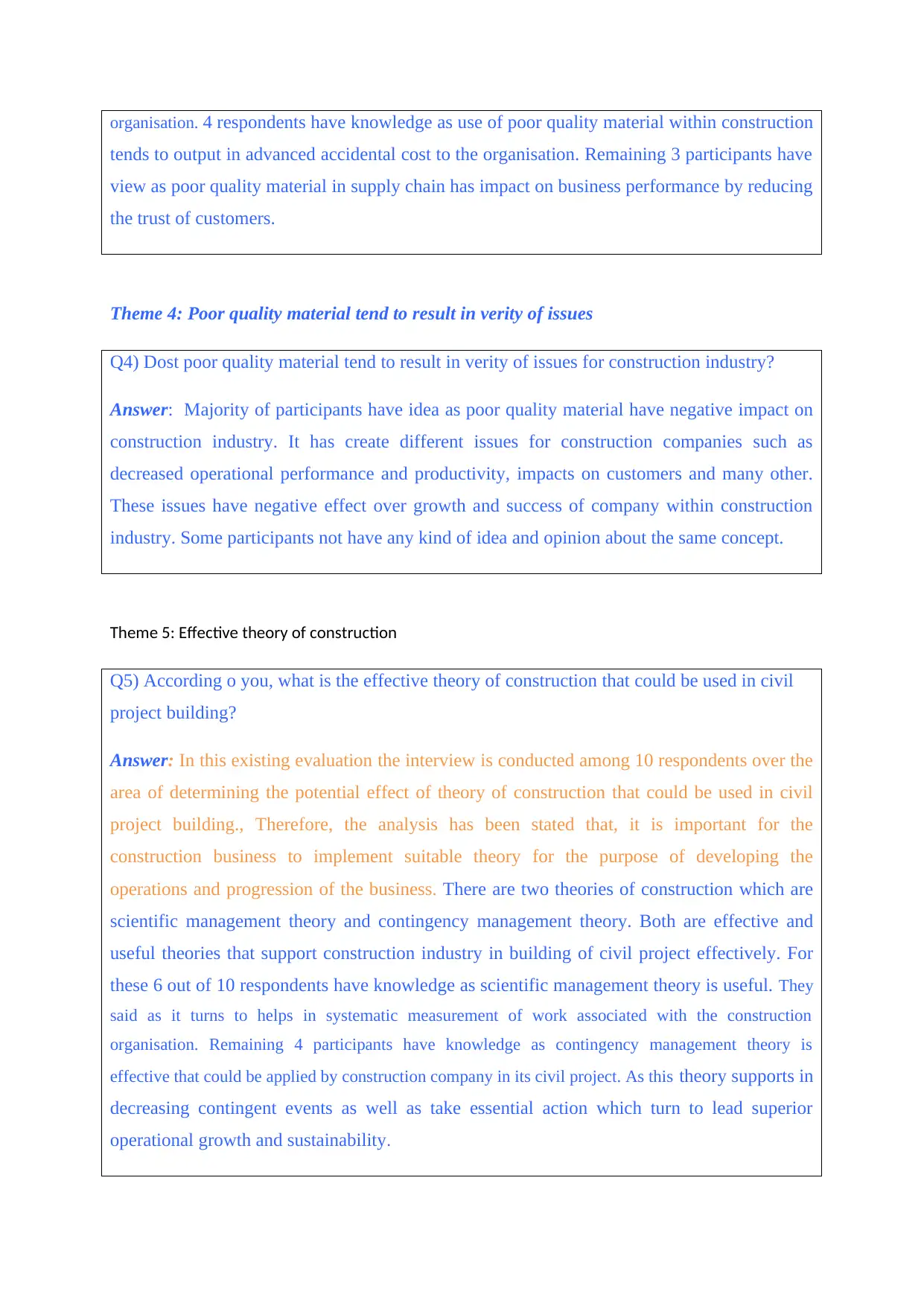
organisation. 4 respondents have knowledge as use of poor quality material within construction
tends to output in advanced accidental cost to the organisation. Remaining 3 participants have
view as poor quality material in supply chain has impact on business performance by reducing
the trust of customers.
Theme 4: Poor quality material tend to result in verity of issues
Q4) Dost poor quality material tend to result in verity of issues for construction industry?
Answer: Majority of participants have idea as poor quality material have negative impact on
construction industry. It has create different issues for construction companies such as
decreased operational performance and productivity, impacts on customers and many other.
These issues have negative effect over growth and success of company within construction
industry. Some participants not have any kind of idea and opinion about the same concept.
Theme 5: Effective theory of construction
Q5) According o you, what is the effective theory of construction that could be used in civil
project building?
Answer: In this existing evaluation the interview is conducted among 10 respondents over the
area of determining the potential effect of theory of construction that could be used in civil
project building., Therefore, the analysis has been stated that, it is important for the
construction business to implement suitable theory for the purpose of developing the
operations and progression of the business. There are two theories of construction which are
scientific management theory and contingency management theory. Both are effective and
useful theories that support construction industry in building of civil project effectively. For
these 6 out of 10 respondents have knowledge as scientific management theory is useful. They
said as it turns to helps in systematic measurement of work associated with the construction
organisation. Remaining 4 participants have knowledge as contingency management theory is
effective that could be applied by construction company in its civil project. As this theory supports in
decreasing contingent events as well as take essential action which turn to lead superior
operational growth and sustainability.
tends to output in advanced accidental cost to the organisation. Remaining 3 participants have
view as poor quality material in supply chain has impact on business performance by reducing
the trust of customers.
Theme 4: Poor quality material tend to result in verity of issues
Q4) Dost poor quality material tend to result in verity of issues for construction industry?
Answer: Majority of participants have idea as poor quality material have negative impact on
construction industry. It has create different issues for construction companies such as
decreased operational performance and productivity, impacts on customers and many other.
These issues have negative effect over growth and success of company within construction
industry. Some participants not have any kind of idea and opinion about the same concept.
Theme 5: Effective theory of construction
Q5) According o you, what is the effective theory of construction that could be used in civil
project building?
Answer: In this existing evaluation the interview is conducted among 10 respondents over the
area of determining the potential effect of theory of construction that could be used in civil
project building., Therefore, the analysis has been stated that, it is important for the
construction business to implement suitable theory for the purpose of developing the
operations and progression of the business. There are two theories of construction which are
scientific management theory and contingency management theory. Both are effective and
useful theories that support construction industry in building of civil project effectively. For
these 6 out of 10 respondents have knowledge as scientific management theory is useful. They
said as it turns to helps in systematic measurement of work associated with the construction
organisation. Remaining 4 participants have knowledge as contingency management theory is
effective that could be applied by construction company in its civil project. As this theory supports in
decreasing contingent events as well as take essential action which turn to lead superior
operational growth and sustainability.
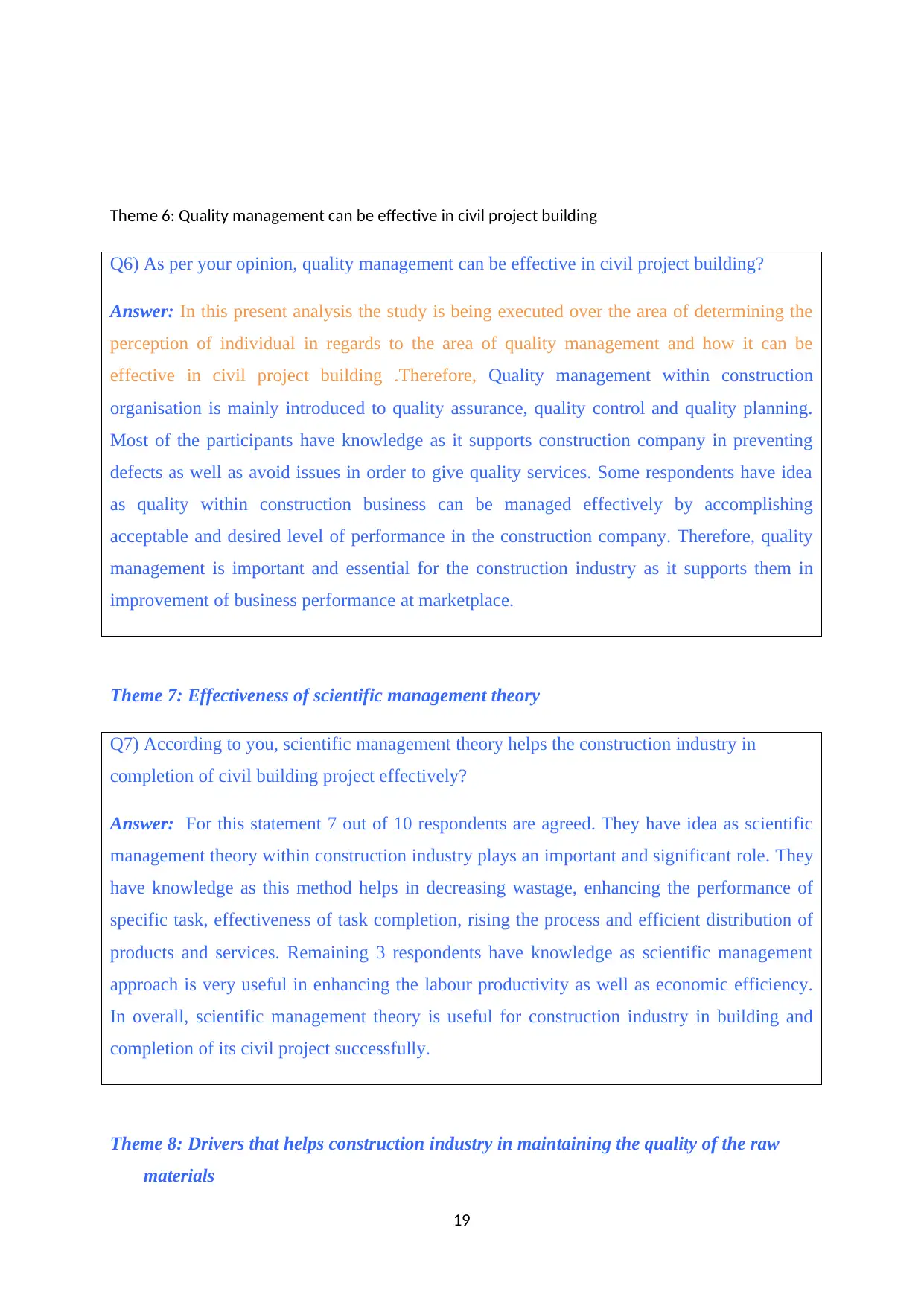
Theme 6: Quality management can be effective in civil project building
Q6) As per your opinion, quality management can be effective in civil project building?
Answer: In this present analysis the study is being executed over the area of determining the
perception of individual in regards to the area of quality management and how it can be
effective in civil project building .Therefore, Quality management within construction
organisation is mainly introduced to quality assurance, quality control and quality planning.
Most of the participants have knowledge as it supports construction company in preventing
defects as well as avoid issues in order to give quality services. Some respondents have idea
as quality within construction business can be managed effectively by accomplishing
acceptable and desired level of performance in the construction company. Therefore, quality
management is important and essential for the construction industry as it supports them in
improvement of business performance at marketplace.
Theme 7: Effectiveness of scientific management theory
Q7) According to you, scientific management theory helps the construction industry in
completion of civil building project effectively?
Answer: For this statement 7 out of 10 respondents are agreed. They have idea as scientific
management theory within construction industry plays an important and significant role. They
have knowledge as this method helps in decreasing wastage, enhancing the performance of
specific task, effectiveness of task completion, rising the process and efficient distribution of
products and services. Remaining 3 respondents have knowledge as scientific management
approach is very useful in enhancing the labour productivity as well as economic efficiency.
In overall, scientific management theory is useful for construction industry in building and
completion of its civil project successfully.
Theme 8: Drivers that helps construction industry in maintaining the quality of the raw
materials
19
Q6) As per your opinion, quality management can be effective in civil project building?
Answer: In this present analysis the study is being executed over the area of determining the
perception of individual in regards to the area of quality management and how it can be
effective in civil project building .Therefore, Quality management within construction
organisation is mainly introduced to quality assurance, quality control and quality planning.
Most of the participants have knowledge as it supports construction company in preventing
defects as well as avoid issues in order to give quality services. Some respondents have idea
as quality within construction business can be managed effectively by accomplishing
acceptable and desired level of performance in the construction company. Therefore, quality
management is important and essential for the construction industry as it supports them in
improvement of business performance at marketplace.
Theme 7: Effectiveness of scientific management theory
Q7) According to you, scientific management theory helps the construction industry in
completion of civil building project effectively?
Answer: For this statement 7 out of 10 respondents are agreed. They have idea as scientific
management theory within construction industry plays an important and significant role. They
have knowledge as this method helps in decreasing wastage, enhancing the performance of
specific task, effectiveness of task completion, rising the process and efficient distribution of
products and services. Remaining 3 respondents have knowledge as scientific management
approach is very useful in enhancing the labour productivity as well as economic efficiency.
In overall, scientific management theory is useful for construction industry in building and
completion of its civil project successfully.
Theme 8: Drivers that helps construction industry in maintaining the quality of the raw
materials
19
Paraphrase This Document
Need a fresh take? Get an instant paraphrase of this document with our AI Paraphraser
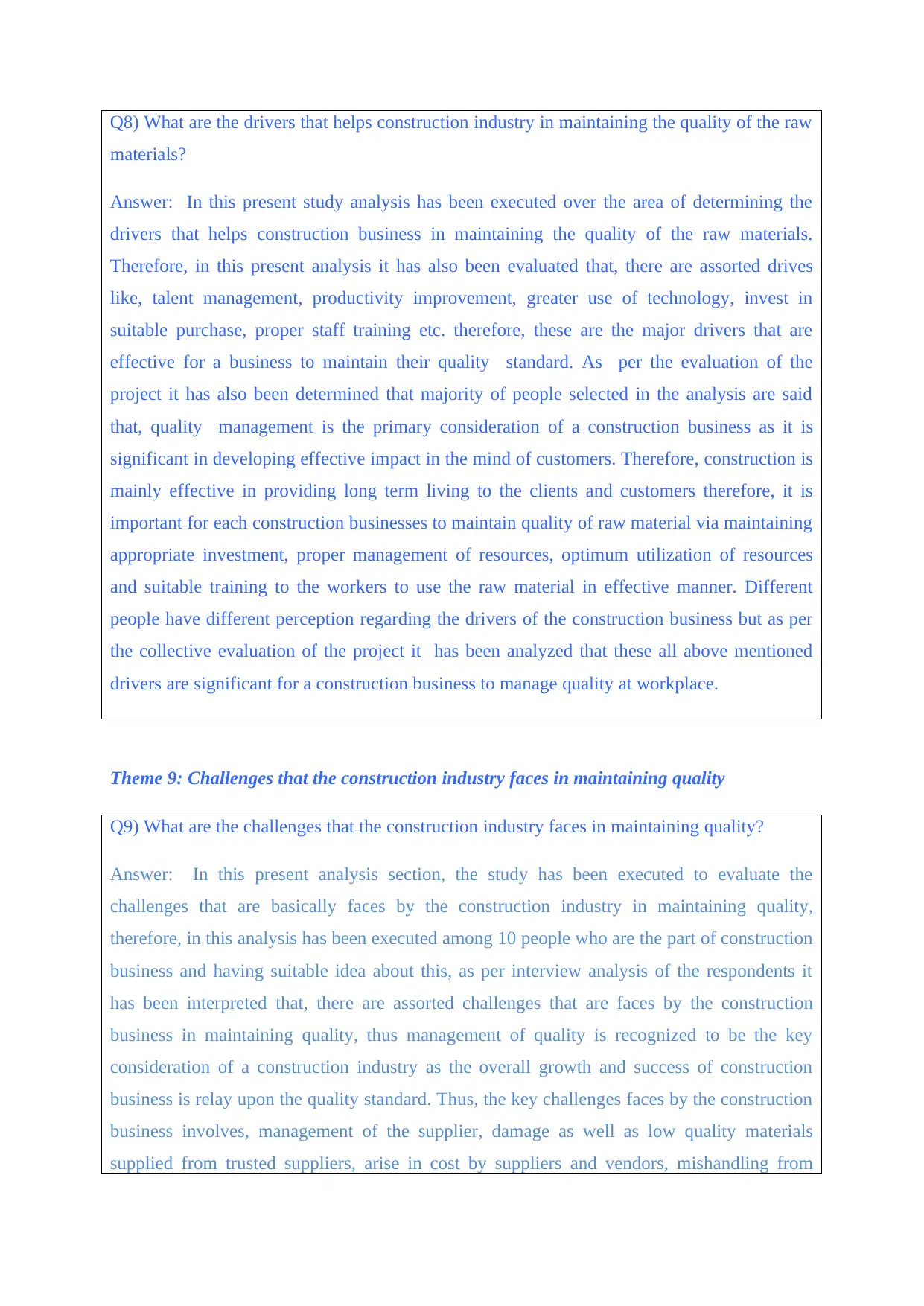
Q8) What are the drivers that helps construction industry in maintaining the quality of the raw
materials?
Answer: In this present study analysis has been executed over the area of determining the
drivers that helps construction business in maintaining the quality of the raw materials.
Therefore, in this present analysis it has also been evaluated that, there are assorted drives
like, talent management, productivity improvement, greater use of technology, invest in
suitable purchase, proper staff training etc. therefore, these are the major drivers that are
effective for a business to maintain their quality standard. As per the evaluation of the
project it has also been determined that majority of people selected in the analysis are said
that, quality management is the primary consideration of a construction business as it is
significant in developing effective impact in the mind of customers. Therefore, construction is
mainly effective in providing long term living to the clients and customers therefore, it is
important for each construction businesses to maintain quality of raw material via maintaining
appropriate investment, proper management of resources, optimum utilization of resources
and suitable training to the workers to use the raw material in effective manner. Different
people have different perception regarding the drivers of the construction business but as per
the collective evaluation of the project it has been analyzed that these all above mentioned
drivers are significant for a construction business to manage quality at workplace.
Theme 9: Challenges that the construction industry faces in maintaining quality
Q9) What are the challenges that the construction industry faces in maintaining quality?
Answer: In this present analysis section, the study has been executed to evaluate the
challenges that are basically faces by the construction industry in maintaining quality,
therefore, in this analysis has been executed among 10 people who are the part of construction
business and having suitable idea about this, as per interview analysis of the respondents it
has been interpreted that, there are assorted challenges that are faces by the construction
business in maintaining quality, thus management of quality is recognized to be the key
consideration of a construction industry as the overall growth and success of construction
business is relay upon the quality standard. Thus, the key challenges faces by the construction
business involves, management of the supplier, damage as well as low quality materials
supplied from trusted suppliers, arise in cost by suppliers and vendors, mishandling from
materials?
Answer: In this present study analysis has been executed over the area of determining the
drivers that helps construction business in maintaining the quality of the raw materials.
Therefore, in this present analysis it has also been evaluated that, there are assorted drives
like, talent management, productivity improvement, greater use of technology, invest in
suitable purchase, proper staff training etc. therefore, these are the major drivers that are
effective for a business to maintain their quality standard. As per the evaluation of the
project it has also been determined that majority of people selected in the analysis are said
that, quality management is the primary consideration of a construction business as it is
significant in developing effective impact in the mind of customers. Therefore, construction is
mainly effective in providing long term living to the clients and customers therefore, it is
important for each construction businesses to maintain quality of raw material via maintaining
appropriate investment, proper management of resources, optimum utilization of resources
and suitable training to the workers to use the raw material in effective manner. Different
people have different perception regarding the drivers of the construction business but as per
the collective evaluation of the project it has been analyzed that these all above mentioned
drivers are significant for a construction business to manage quality at workplace.
Theme 9: Challenges that the construction industry faces in maintaining quality
Q9) What are the challenges that the construction industry faces in maintaining quality?
Answer: In this present analysis section, the study has been executed to evaluate the
challenges that are basically faces by the construction industry in maintaining quality,
therefore, in this analysis has been executed among 10 people who are the part of construction
business and having suitable idea about this, as per interview analysis of the respondents it
has been interpreted that, there are assorted challenges that are faces by the construction
business in maintaining quality, thus management of quality is recognized to be the key
consideration of a construction industry as the overall growth and success of construction
business is relay upon the quality standard. Thus, the key challenges faces by the construction
business involves, management of the supplier, damage as well as low quality materials
supplied from trusted suppliers, arise in cost by suppliers and vendors, mishandling from
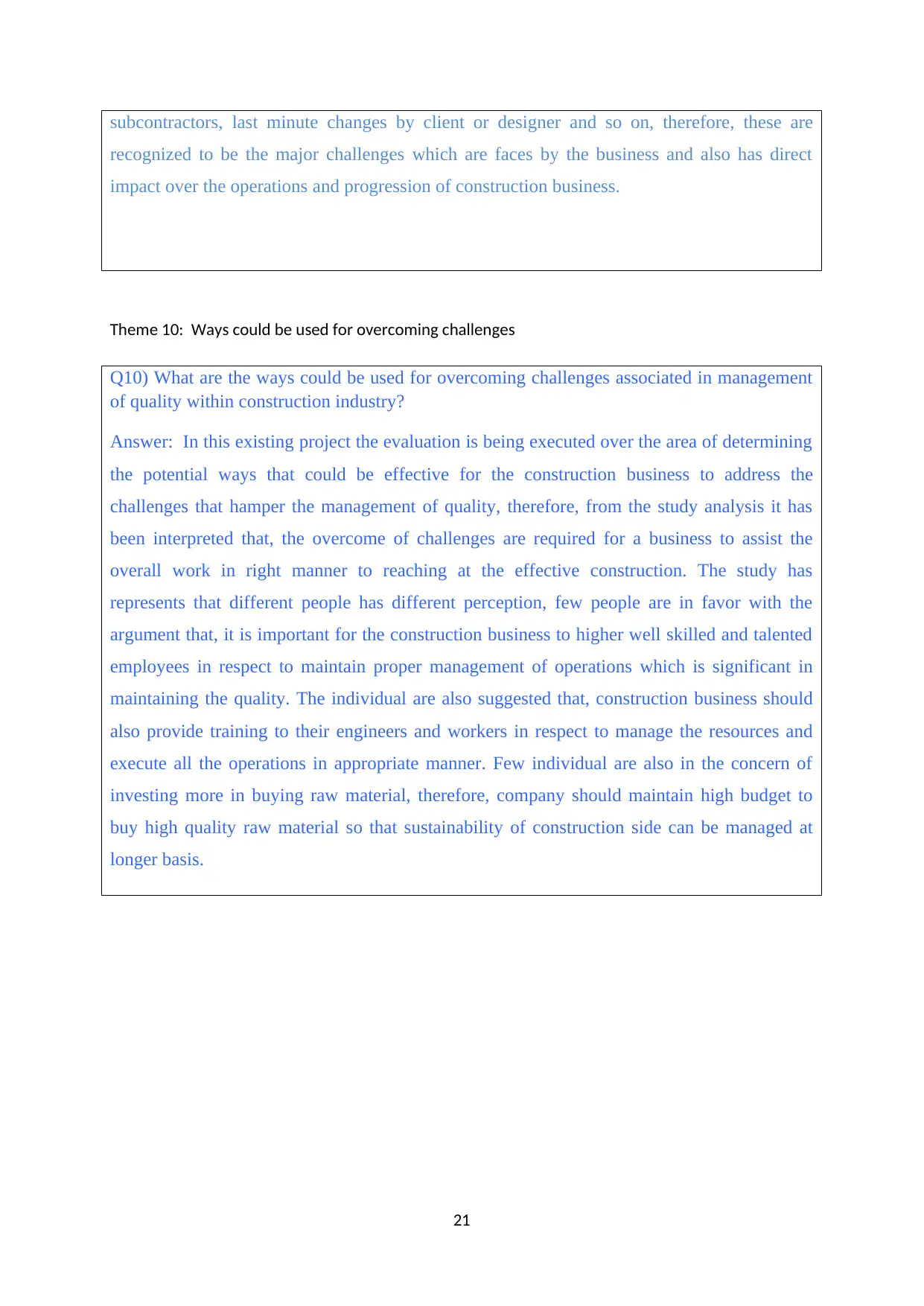
subcontractors, last minute changes by client or designer and so on, therefore, these are
recognized to be the major challenges which are faces by the business and also has direct
impact over the operations and progression of construction business.
Theme 10: Ways could be used for overcoming challenges
Q10) What are the ways could be used for overcoming challenges associated in management
of quality within construction industry?
Answer: In this existing project the evaluation is being executed over the area of determining
the potential ways that could be effective for the construction business to address the
challenges that hamper the management of quality, therefore, from the study analysis it has
been interpreted that, the overcome of challenges are required for a business to assist the
overall work in right manner to reaching at the effective construction. The study has
represents that different people has different perception, few people are in favor with the
argument that, it is important for the construction business to higher well skilled and talented
employees in respect to maintain proper management of operations which is significant in
maintaining the quality. The individual are also suggested that, construction business should
also provide training to their engineers and workers in respect to manage the resources and
execute all the operations in appropriate manner. Few individual are also in the concern of
investing more in buying raw material, therefore, company should maintain high budget to
buy high quality raw material so that sustainability of construction side can be managed at
longer basis.
21
recognized to be the major challenges which are faces by the business and also has direct
impact over the operations and progression of construction business.
Theme 10: Ways could be used for overcoming challenges
Q10) What are the ways could be used for overcoming challenges associated in management
of quality within construction industry?
Answer: In this existing project the evaluation is being executed over the area of determining
the potential ways that could be effective for the construction business to address the
challenges that hamper the management of quality, therefore, from the study analysis it has
been interpreted that, the overcome of challenges are required for a business to assist the
overall work in right manner to reaching at the effective construction. The study has
represents that different people has different perception, few people are in favor with the
argument that, it is important for the construction business to higher well skilled and talented
employees in respect to maintain proper management of operations which is significant in
maintaining the quality. The individual are also suggested that, construction business should
also provide training to their engineers and workers in respect to manage the resources and
execute all the operations in appropriate manner. Few individual are also in the concern of
investing more in buying raw material, therefore, company should maintain high budget to
buy high quality raw material so that sustainability of construction side can be managed at
longer basis.
21
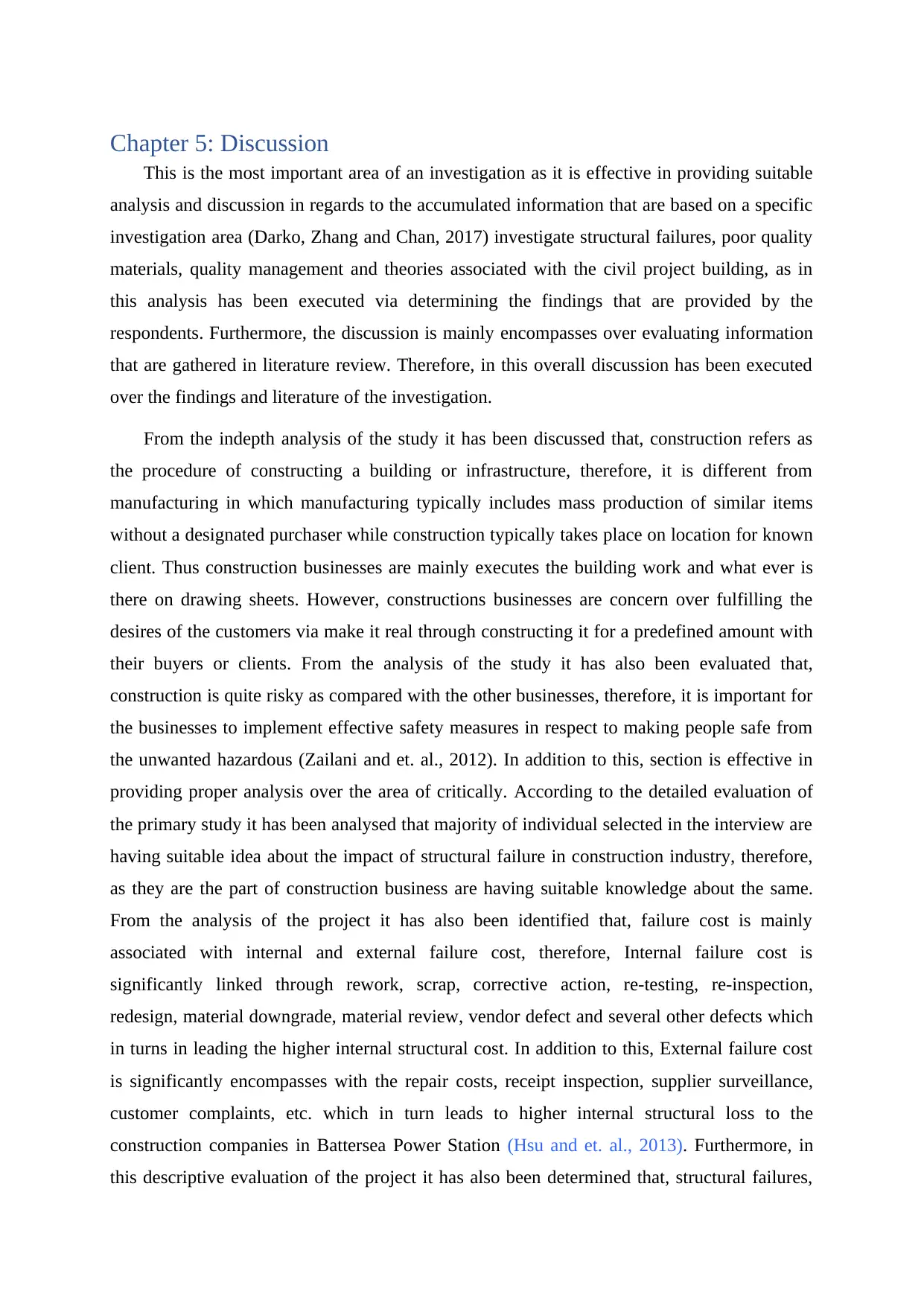
Chapter 5: Discussion
This is the most important area of an investigation as it is effective in providing suitable
analysis and discussion in regards to the accumulated information that are based on a specific
investigation area (Darko, Zhang and Chan, 2017) investigate structural failures, poor quality
materials, quality management and theories associated with the civil project building, as in
this analysis has been executed via determining the findings that are provided by the
respondents. Furthermore, the discussion is mainly encompasses over evaluating information
that are gathered in literature review. Therefore, in this overall discussion has been executed
over the findings and literature of the investigation.
From the indepth analysis of the study it has been discussed that, construction refers as
the procedure of constructing a building or infrastructure, therefore, it is different from
manufacturing in which manufacturing typically includes mass production of similar items
without a designated purchaser while construction typically takes place on location for known
client. Thus construction businesses are mainly executes the building work and what ever is
there on drawing sheets. However, constructions businesses are concern over fulfilling the
desires of the customers via make it real through constructing it for a predefined amount with
their buyers or clients. From the analysis of the study it has also been evaluated that,
construction is quite risky as compared with the other businesses, therefore, it is important for
the businesses to implement effective safety measures in respect to making people safe from
the unwanted hazardous (Zailani and et. al., 2012). In addition to this, section is effective in
providing proper analysis over the area of critically. According to the detailed evaluation of
the primary study it has been analysed that majority of individual selected in the interview are
having suitable idea about the impact of structural failure in construction industry, therefore,
as they are the part of construction business are having suitable knowledge about the same.
From the analysis of the project it has also been identified that, failure cost is mainly
associated with internal and external failure cost, therefore, Internal failure cost is
significantly linked through rework, scrap, corrective action, re-testing, re-inspection,
redesign, material downgrade, material review, vendor defect and several other defects which
in turns in leading the higher internal structural cost. In addition to this, External failure cost
is significantly encompasses with the repair costs, receipt inspection, supplier surveillance,
customer complaints, etc. which in turn leads to higher internal structural loss to the
construction companies in Battersea Power Station (Hsu and et. al., 2013). Furthermore, in
this descriptive evaluation of the project it has also been determined that, structural failures,
This is the most important area of an investigation as it is effective in providing suitable
analysis and discussion in regards to the accumulated information that are based on a specific
investigation area (Darko, Zhang and Chan, 2017) investigate structural failures, poor quality
materials, quality management and theories associated with the civil project building, as in
this analysis has been executed via determining the findings that are provided by the
respondents. Furthermore, the discussion is mainly encompasses over evaluating information
that are gathered in literature review. Therefore, in this overall discussion has been executed
over the findings and literature of the investigation.
From the indepth analysis of the study it has been discussed that, construction refers as
the procedure of constructing a building or infrastructure, therefore, it is different from
manufacturing in which manufacturing typically includes mass production of similar items
without a designated purchaser while construction typically takes place on location for known
client. Thus construction businesses are mainly executes the building work and what ever is
there on drawing sheets. However, constructions businesses are concern over fulfilling the
desires of the customers via make it real through constructing it for a predefined amount with
their buyers or clients. From the analysis of the study it has also been evaluated that,
construction is quite risky as compared with the other businesses, therefore, it is important for
the businesses to implement effective safety measures in respect to making people safe from
the unwanted hazardous (Zailani and et. al., 2012). In addition to this, section is effective in
providing proper analysis over the area of critically. According to the detailed evaluation of
the primary study it has been analysed that majority of individual selected in the interview are
having suitable idea about the impact of structural failure in construction industry, therefore,
as they are the part of construction business are having suitable knowledge about the same.
From the analysis of the project it has also been identified that, failure cost is mainly
associated with internal and external failure cost, therefore, Internal failure cost is
significantly linked through rework, scrap, corrective action, re-testing, re-inspection,
redesign, material downgrade, material review, vendor defect and several other defects which
in turns in leading the higher internal structural cost. In addition to this, External failure cost
is significantly encompasses with the repair costs, receipt inspection, supplier surveillance,
customer complaints, etc. which in turn leads to higher internal structural loss to the
construction companies in Battersea Power Station (Hsu and et. al., 2013). Furthermore, in
this descriptive evaluation of the project it has also been determined that, structural failures,
Secure Best Marks with AI Grader
Need help grading? Try our AI Grader for instant feedback on your assignments.
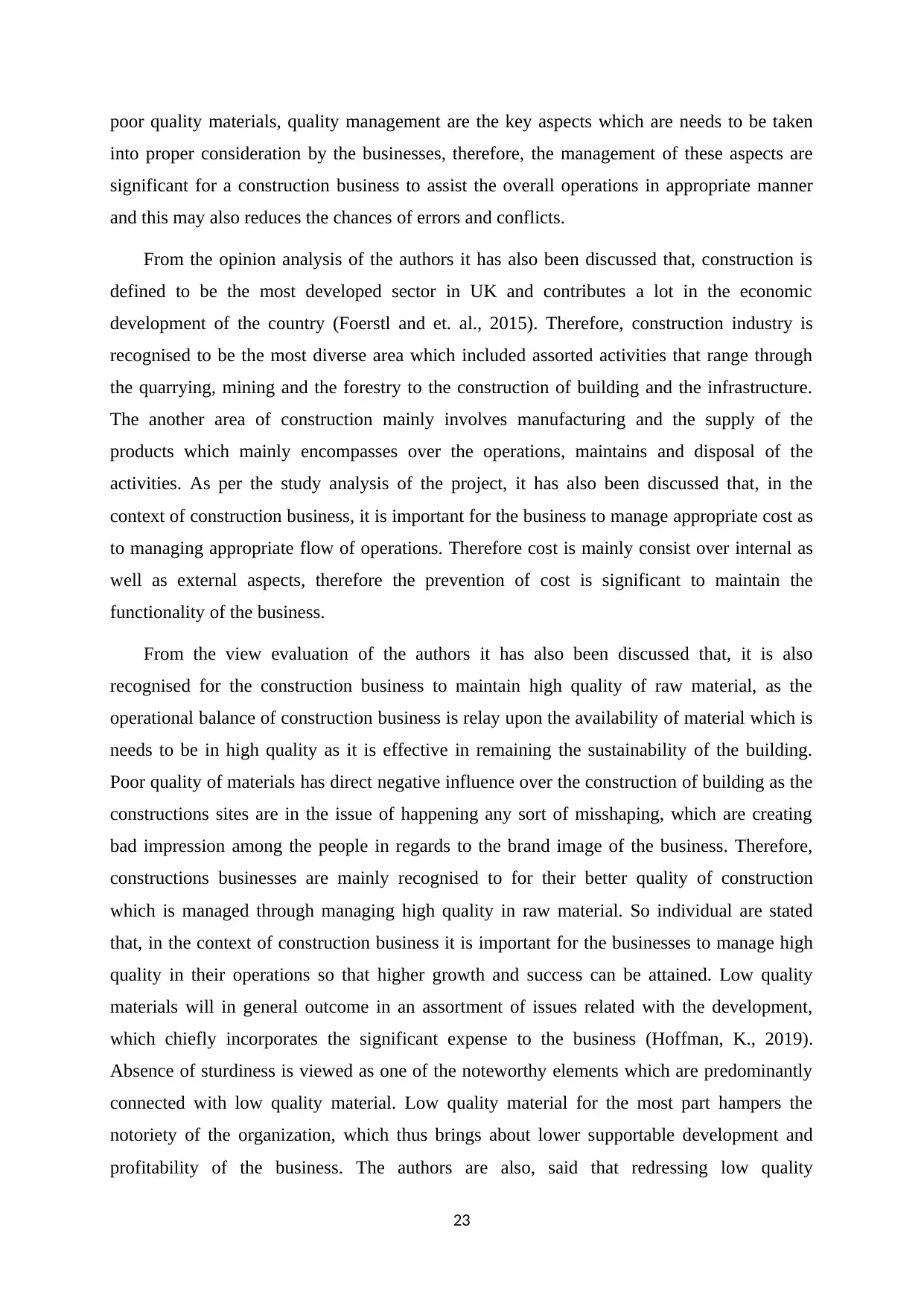
poor quality materials, quality management are the key aspects which are needs to be taken
into proper consideration by the businesses, therefore, the management of these aspects are
significant for a construction business to assist the overall operations in appropriate manner
and this may also reduces the chances of errors and conflicts.
From the opinion analysis of the authors it has also been discussed that, construction is
defined to be the most developed sector in UK and contributes a lot in the economic
development of the country (Foerstl and et. al., 2015). Therefore, construction industry is
recognised to be the most diverse area which included assorted activities that range through
the quarrying, mining and the forestry to the construction of building and the infrastructure.
The another area of construction mainly involves manufacturing and the supply of the
products which mainly encompasses over the operations, maintains and disposal of the
activities. As per the study analysis of the project, it has also been discussed that, in the
context of construction business, it is important for the business to manage appropriate cost as
to managing appropriate flow of operations. Therefore cost is mainly consist over internal as
well as external aspects, therefore the prevention of cost is significant to maintain the
functionality of the business.
From the view evaluation of the authors it has also been discussed that, it is also
recognised for the construction business to maintain high quality of raw material, as the
operational balance of construction business is relay upon the availability of material which is
needs to be in high quality as it is effective in remaining the sustainability of the building.
Poor quality of materials has direct negative influence over the construction of building as the
constructions sites are in the issue of happening any sort of misshaping, which are creating
bad impression among the people in regards to the brand image of the business. Therefore,
constructions businesses are mainly recognised to for their better quality of construction
which is managed through managing high quality in raw material. So individual are stated
that, in the context of construction business it is important for the businesses to manage high
quality in their operations so that higher growth and success can be attained. Low quality
materials will in general outcome in an assortment of issues related with the development,
which chiefly incorporates the significant expense to the business (Hoffman, K., 2019).
Absence of sturdiness is viewed as one of the noteworthy elements which are predominantly
connected with low quality material. Low quality material for the most part hampers the
notoriety of the organization, which thus brings about lower supportable development and
profitability of the business. The authors are also, said that redressing low quality
23
into proper consideration by the businesses, therefore, the management of these aspects are
significant for a construction business to assist the overall operations in appropriate manner
and this may also reduces the chances of errors and conflicts.
From the opinion analysis of the authors it has also been discussed that, construction is
defined to be the most developed sector in UK and contributes a lot in the economic
development of the country (Foerstl and et. al., 2015). Therefore, construction industry is
recognised to be the most diverse area which included assorted activities that range through
the quarrying, mining and the forestry to the construction of building and the infrastructure.
The another area of construction mainly involves manufacturing and the supply of the
products which mainly encompasses over the operations, maintains and disposal of the
activities. As per the study analysis of the project, it has also been discussed that, in the
context of construction business, it is important for the business to manage appropriate cost as
to managing appropriate flow of operations. Therefore cost is mainly consist over internal as
well as external aspects, therefore the prevention of cost is significant to maintain the
functionality of the business.
From the view evaluation of the authors it has also been discussed that, it is also
recognised for the construction business to maintain high quality of raw material, as the
operational balance of construction business is relay upon the availability of material which is
needs to be in high quality as it is effective in remaining the sustainability of the building.
Poor quality of materials has direct negative influence over the construction of building as the
constructions sites are in the issue of happening any sort of misshaping, which are creating
bad impression among the people in regards to the brand image of the business. Therefore,
constructions businesses are mainly recognised to for their better quality of construction
which is managed through managing high quality in raw material. So individual are stated
that, in the context of construction business it is important for the businesses to manage high
quality in their operations so that higher growth and success can be attained. Low quality
materials will in general outcome in an assortment of issues related with the development,
which chiefly incorporates the significant expense to the business (Hoffman, K., 2019).
Absence of sturdiness is viewed as one of the noteworthy elements which are predominantly
connected with low quality material. Low quality material for the most part hampers the
notoriety of the organization, which thus brings about lower supportable development and
profitability of the business. The authors are also, said that redressing low quality
23
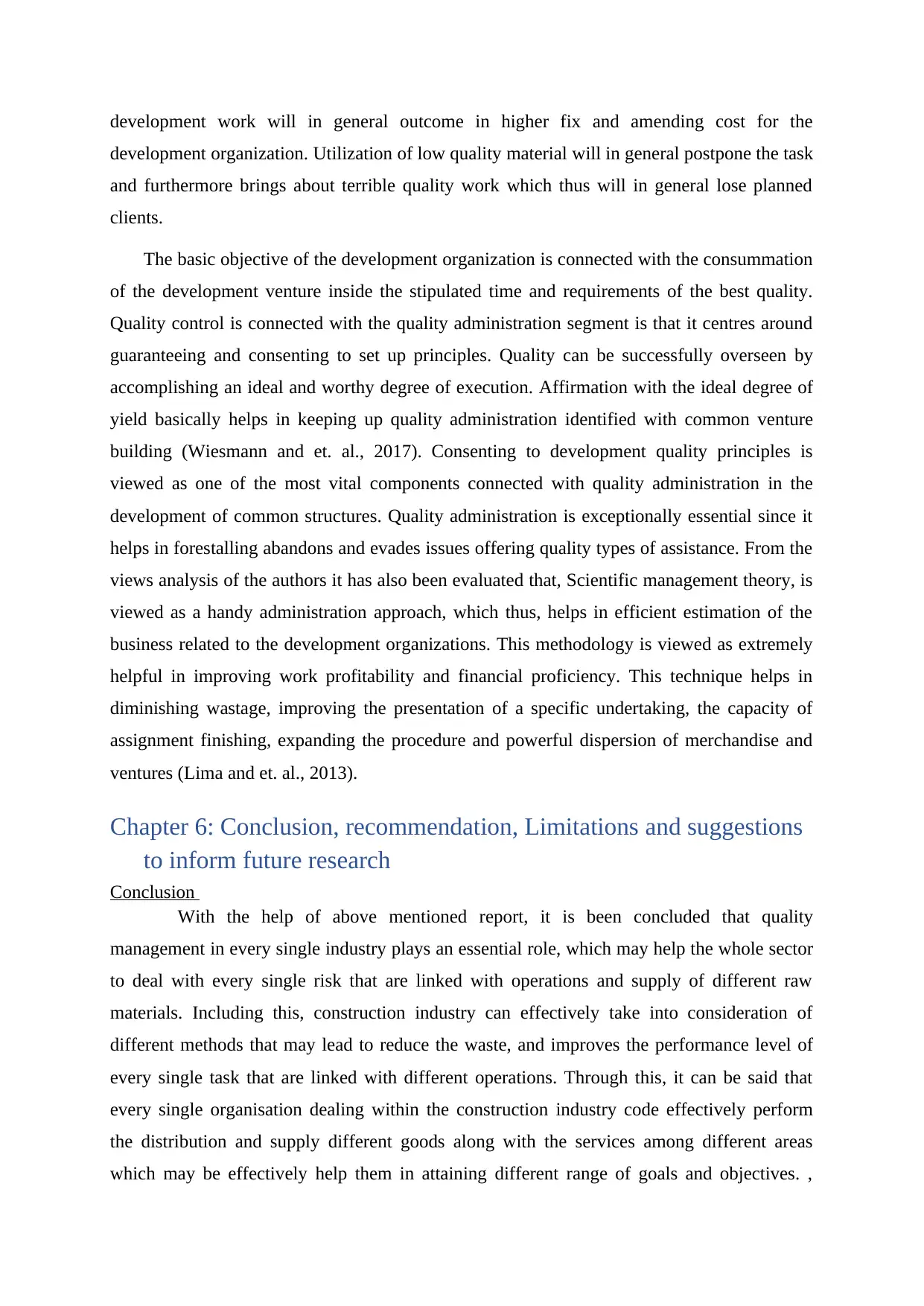
development work will in general outcome in higher fix and amending cost for the
development organization. Utilization of low quality material will in general postpone the task
and furthermore brings about terrible quality work which thus will in general lose planned
clients.
The basic objective of the development organization is connected with the consummation
of the development venture inside the stipulated time and requirements of the best quality.
Quality control is connected with the quality administration segment is that it centres around
guaranteeing and consenting to set up principles. Quality can be successfully overseen by
accomplishing an ideal and worthy degree of execution. Affirmation with the ideal degree of
yield basically helps in keeping up quality administration identified with common venture
building (Wiesmann and et. al., 2017). Consenting to development quality principles is
viewed as one of the most vital components connected with quality administration in the
development of common structures. Quality administration is exceptionally essential since it
helps in forestalling abandons and evades issues offering quality types of assistance. From the
views analysis of the authors it has also been evaluated that, Scientific management theory, is
viewed as a handy administration approach, which thus, helps in efficient estimation of the
business related to the development organizations. This methodology is viewed as extremely
helpful in improving work profitability and financial proficiency. This technique helps in
diminishing wastage, improving the presentation of a specific undertaking, the capacity of
assignment finishing, expanding the procedure and powerful dispersion of merchandise and
ventures (Lima and et. al., 2013).
Chapter 6: Conclusion, recommendation, Limitations and suggestions
to inform future research
Conclusion
With the help of above mentioned report, it is been concluded that quality
management in every single industry plays an essential role, which may help the whole sector
to deal with every single risk that are linked with operations and supply of different raw
materials. Including this, construction industry can effectively take into consideration of
different methods that may lead to reduce the waste, and improves the performance level of
every single task that are linked with different operations. Through this, it can be said that
every single organisation dealing within the construction industry code effectively perform
the distribution and supply different goods along with the services among different areas
which may be effectively help them in attaining different range of goals and objectives. ,
development organization. Utilization of low quality material will in general postpone the task
and furthermore brings about terrible quality work which thus will in general lose planned
clients.
The basic objective of the development organization is connected with the consummation
of the development venture inside the stipulated time and requirements of the best quality.
Quality control is connected with the quality administration segment is that it centres around
guaranteeing and consenting to set up principles. Quality can be successfully overseen by
accomplishing an ideal and worthy degree of execution. Affirmation with the ideal degree of
yield basically helps in keeping up quality administration identified with common venture
building (Wiesmann and et. al., 2017). Consenting to development quality principles is
viewed as one of the most vital components connected with quality administration in the
development of common structures. Quality administration is exceptionally essential since it
helps in forestalling abandons and evades issues offering quality types of assistance. From the
views analysis of the authors it has also been evaluated that, Scientific management theory, is
viewed as a handy administration approach, which thus, helps in efficient estimation of the
business related to the development organizations. This methodology is viewed as extremely
helpful in improving work profitability and financial proficiency. This technique helps in
diminishing wastage, improving the presentation of a specific undertaking, the capacity of
assignment finishing, expanding the procedure and powerful dispersion of merchandise and
ventures (Lima and et. al., 2013).
Chapter 6: Conclusion, recommendation, Limitations and suggestions
to inform future research
Conclusion
With the help of above mentioned report, it is been concluded that quality
management in every single industry plays an essential role, which may help the whole sector
to deal with every single risk that are linked with operations and supply of different raw
materials. Including this, construction industry can effectively take into consideration of
different methods that may lead to reduce the waste, and improves the performance level of
every single task that are linked with different operations. Through this, it can be said that
every single organisation dealing within the construction industry code effectively perform
the distribution and supply different goods along with the services among different areas
which may be effectively help them in attaining different range of goals and objectives. ,
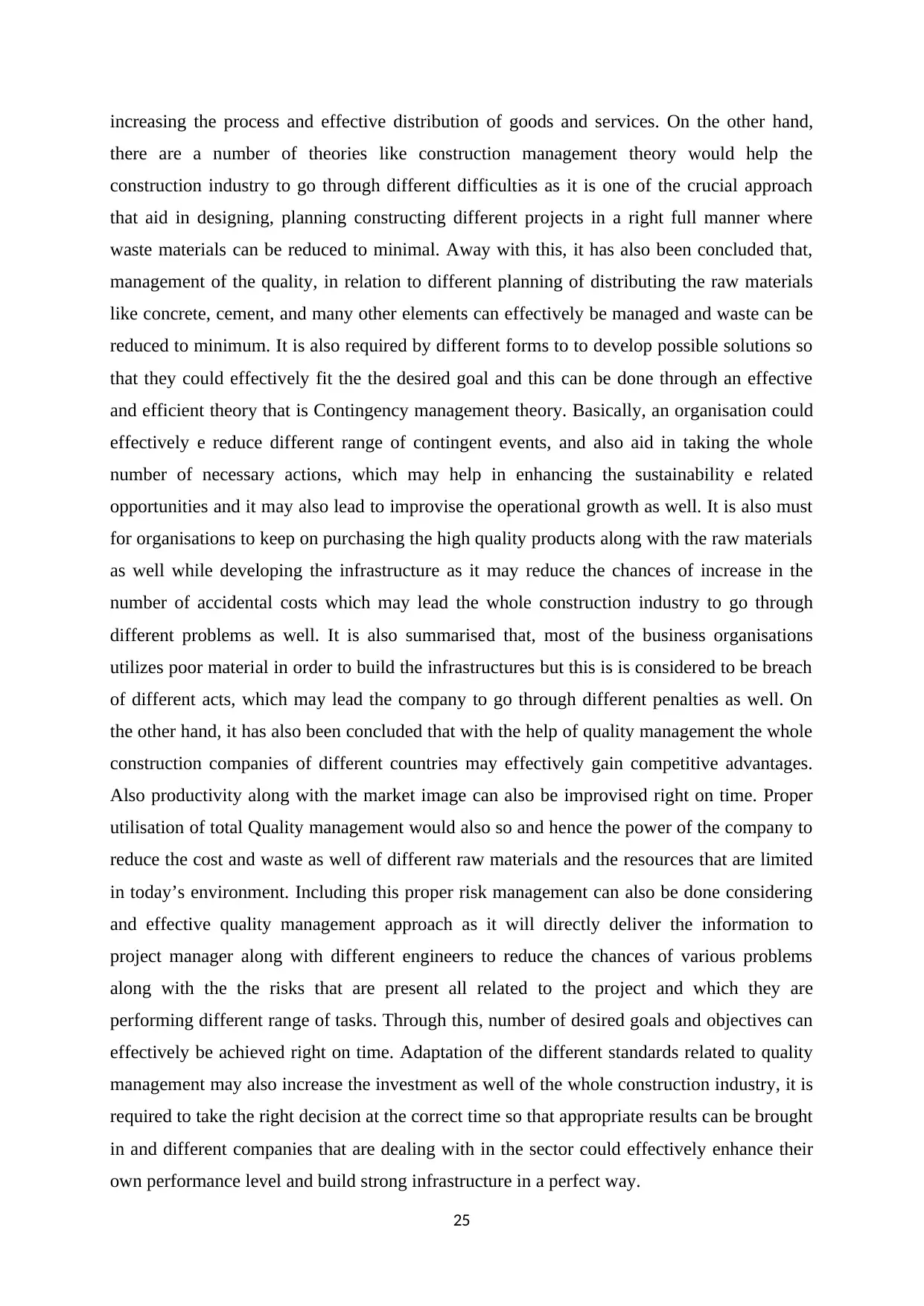
increasing the process and effective distribution of goods and services. On the other hand,
there are a number of theories like construction management theory would help the
construction industry to go through different difficulties as it is one of the crucial approach
that aid in designing, planning constructing different projects in a right full manner where
waste materials can be reduced to minimal. Away with this, it has also been concluded that,
management of the quality, in relation to different planning of distributing the raw materials
like concrete, cement, and many other elements can effectively be managed and waste can be
reduced to minimum. It is also required by different forms to to develop possible solutions so
that they could effectively fit the the desired goal and this can be done through an effective
and efficient theory that is Contingency management theory. Basically, an organisation could
effectively e reduce different range of contingent events, and also aid in taking the whole
number of necessary actions, which may help in enhancing the sustainability e related
opportunities and it may also lead to improvise the operational growth as well. It is also must
for organisations to keep on purchasing the high quality products along with the raw materials
as well while developing the infrastructure as it may reduce the chances of increase in the
number of accidental costs which may lead the whole construction industry to go through
different problems as well. It is also summarised that, most of the business organisations
utilizes poor material in order to build the infrastructures but this is is considered to be breach
of different acts, which may lead the company to go through different penalties as well. On
the other hand, it has also been concluded that with the help of quality management the whole
construction companies of different countries may effectively gain competitive advantages.
Also productivity along with the market image can also be improvised right on time. Proper
utilisation of total Quality management would also so and hence the power of the company to
reduce the cost and waste as well of different raw materials and the resources that are limited
in today’s environment. Including this proper risk management can also be done considering
and effective quality management approach as it will directly deliver the information to
project manager along with different engineers to reduce the chances of various problems
along with the the risks that are present all related to the project and which they are
performing different range of tasks. Through this, number of desired goals and objectives can
effectively be achieved right on time. Adaptation of the different standards related to quality
management may also increase the investment as well of the whole construction industry, it is
required to take the right decision at the correct time so that appropriate results can be brought
in and different companies that are dealing with in the sector could effectively enhance their
own performance level and build strong infrastructure in a perfect way.
25
there are a number of theories like construction management theory would help the
construction industry to go through different difficulties as it is one of the crucial approach
that aid in designing, planning constructing different projects in a right full manner where
waste materials can be reduced to minimal. Away with this, it has also been concluded that,
management of the quality, in relation to different planning of distributing the raw materials
like concrete, cement, and many other elements can effectively be managed and waste can be
reduced to minimum. It is also required by different forms to to develop possible solutions so
that they could effectively fit the the desired goal and this can be done through an effective
and efficient theory that is Contingency management theory. Basically, an organisation could
effectively e reduce different range of contingent events, and also aid in taking the whole
number of necessary actions, which may help in enhancing the sustainability e related
opportunities and it may also lead to improvise the operational growth as well. It is also must
for organisations to keep on purchasing the high quality products along with the raw materials
as well while developing the infrastructure as it may reduce the chances of increase in the
number of accidental costs which may lead the whole construction industry to go through
different problems as well. It is also summarised that, most of the business organisations
utilizes poor material in order to build the infrastructures but this is is considered to be breach
of different acts, which may lead the company to go through different penalties as well. On
the other hand, it has also been concluded that with the help of quality management the whole
construction companies of different countries may effectively gain competitive advantages.
Also productivity along with the market image can also be improvised right on time. Proper
utilisation of total Quality management would also so and hence the power of the company to
reduce the cost and waste as well of different raw materials and the resources that are limited
in today’s environment. Including this proper risk management can also be done considering
and effective quality management approach as it will directly deliver the information to
project manager along with different engineers to reduce the chances of various problems
along with the the risks that are present all related to the project and which they are
performing different range of tasks. Through this, number of desired goals and objectives can
effectively be achieved right on time. Adaptation of the different standards related to quality
management may also increase the investment as well of the whole construction industry, it is
required to take the right decision at the correct time so that appropriate results can be brought
in and different companies that are dealing with in the sector could effectively enhance their
own performance level and build strong infrastructure in a perfect way.
25
Paraphrase This Document
Need a fresh take? Get an instant paraphrase of this document with our AI Paraphraser
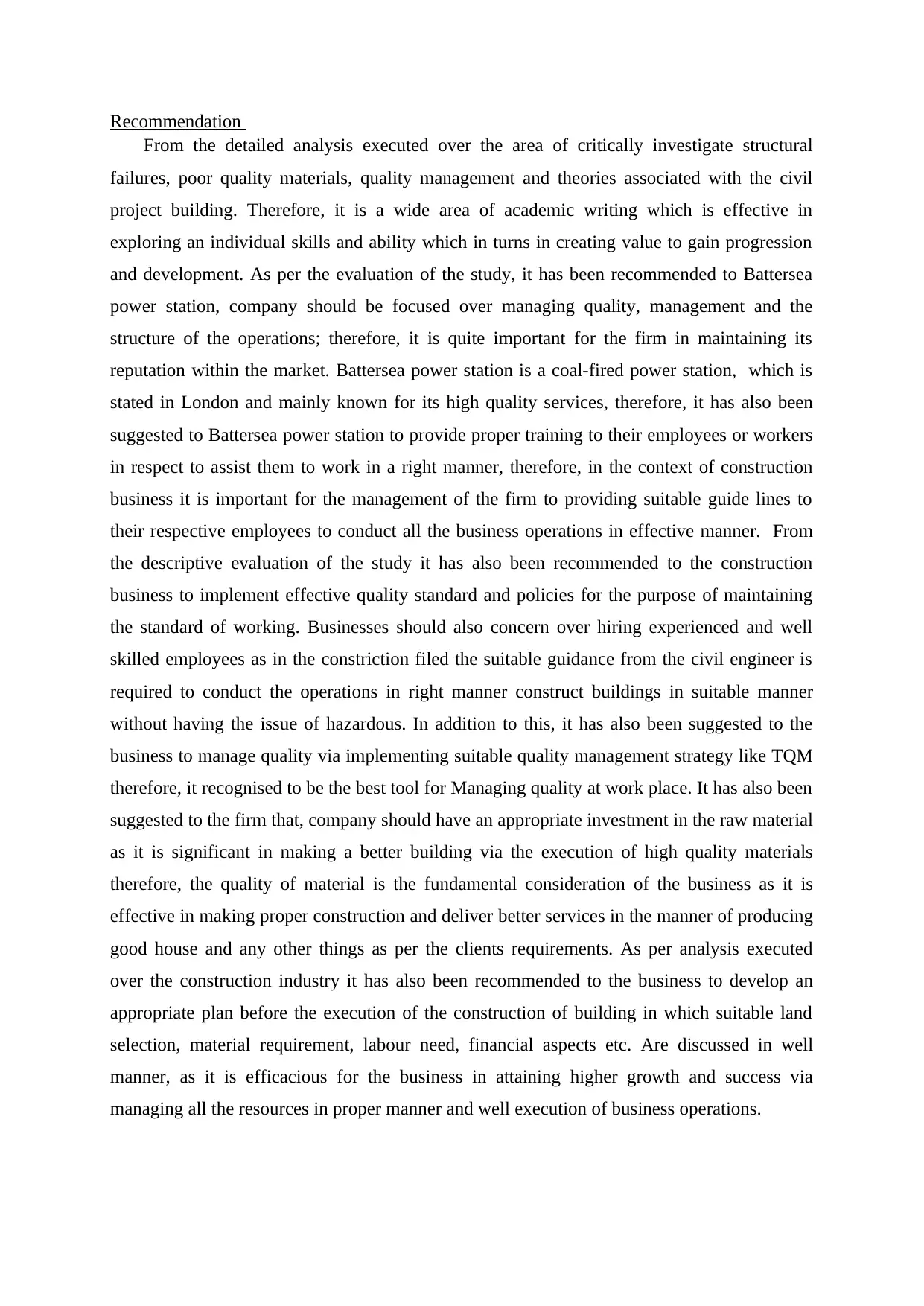
Recommendation
From the detailed analysis executed over the area of critically investigate structural
failures, poor quality materials, quality management and theories associated with the civil
project building. Therefore, it is a wide area of academic writing which is effective in
exploring an individual skills and ability which in turns in creating value to gain progression
and development. As per the evaluation of the study, it has been recommended to Battersea
power station, company should be focused over managing quality, management and the
structure of the operations; therefore, it is quite important for the firm in maintaining its
reputation within the market. Battersea power station is a coal-fired power station, which is
stated in London and mainly known for its high quality services, therefore, it has also been
suggested to Battersea power station to provide proper training to their employees or workers
in respect to assist them to work in a right manner, therefore, in the context of construction
business it is important for the management of the firm to providing suitable guide lines to
their respective employees to conduct all the business operations in effective manner. From
the descriptive evaluation of the study it has also been recommended to the construction
business to implement effective quality standard and policies for the purpose of maintaining
the standard of working. Businesses should also concern over hiring experienced and well
skilled employees as in the constriction filed the suitable guidance from the civil engineer is
required to conduct the operations in right manner construct buildings in suitable manner
without having the issue of hazardous. In addition to this, it has also been suggested to the
business to manage quality via implementing suitable quality management strategy like TQM
therefore, it recognised to be the best tool for Managing quality at work place. It has also been
suggested to the firm that, company should have an appropriate investment in the raw material
as it is significant in making a better building via the execution of high quality materials
therefore, the quality of material is the fundamental consideration of the business as it is
effective in making proper construction and deliver better services in the manner of producing
good house and any other things as per the clients requirements. As per analysis executed
over the construction industry it has also been recommended to the business to develop an
appropriate plan before the execution of the construction of building in which suitable land
selection, material requirement, labour need, financial aspects etc. Are discussed in well
manner, as it is efficacious for the business in attaining higher growth and success via
managing all the resources in proper manner and well execution of business operations.
From the detailed analysis executed over the area of critically investigate structural
failures, poor quality materials, quality management and theories associated with the civil
project building. Therefore, it is a wide area of academic writing which is effective in
exploring an individual skills and ability which in turns in creating value to gain progression
and development. As per the evaluation of the study, it has been recommended to Battersea
power station, company should be focused over managing quality, management and the
structure of the operations; therefore, it is quite important for the firm in maintaining its
reputation within the market. Battersea power station is a coal-fired power station, which is
stated in London and mainly known for its high quality services, therefore, it has also been
suggested to Battersea power station to provide proper training to their employees or workers
in respect to assist them to work in a right manner, therefore, in the context of construction
business it is important for the management of the firm to providing suitable guide lines to
their respective employees to conduct all the business operations in effective manner. From
the descriptive evaluation of the study it has also been recommended to the construction
business to implement effective quality standard and policies for the purpose of maintaining
the standard of working. Businesses should also concern over hiring experienced and well
skilled employees as in the constriction filed the suitable guidance from the civil engineer is
required to conduct the operations in right manner construct buildings in suitable manner
without having the issue of hazardous. In addition to this, it has also been suggested to the
business to manage quality via implementing suitable quality management strategy like TQM
therefore, it recognised to be the best tool for Managing quality at work place. It has also been
suggested to the firm that, company should have an appropriate investment in the raw material
as it is significant in making a better building via the execution of high quality materials
therefore, the quality of material is the fundamental consideration of the business as it is
effective in making proper construction and deliver better services in the manner of producing
good house and any other things as per the clients requirements. As per analysis executed
over the construction industry it has also been recommended to the business to develop an
appropriate plan before the execution of the construction of building in which suitable land
selection, material requirement, labour need, financial aspects etc. Are discussed in well
manner, as it is efficacious for the business in attaining higher growth and success via
managing all the resources in proper manner and well execution of business operations.
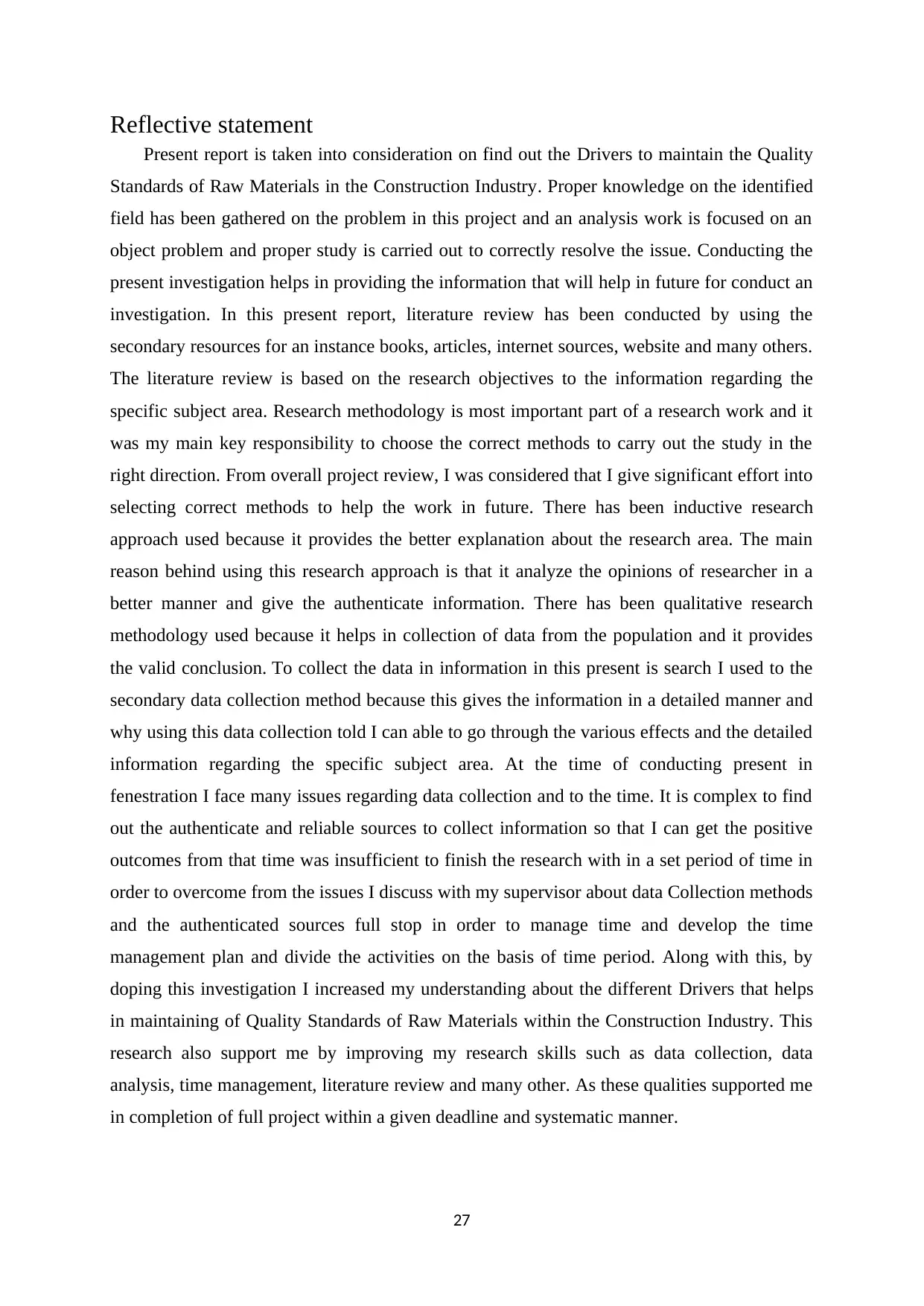
Reflective statement
Present report is taken into consideration on find out the Drivers to maintain the Quality
Standards of Raw Materials in the Construction Industry. Proper knowledge on the identified
field has been gathered on the problem in this project and an analysis work is focused on an
object problem and proper study is carried out to correctly resolve the issue. Conducting the
present investigation helps in providing the information that will help in future for conduct an
investigation. In this present report, literature review has been conducted by using the
secondary resources for an instance books, articles, internet sources, website and many others.
The literature review is based on the research objectives to the information regarding the
specific subject area. Research methodology is most important part of a research work and it
was my main key responsibility to choose the correct methods to carry out the study in the
right direction. From overall project review, I was considered that I give significant effort into
selecting correct methods to help the work in future. There has been inductive research
approach used because it provides the better explanation about the research area. The main
reason behind using this research approach is that it analyze the opinions of researcher in a
better manner and give the authenticate information. There has been qualitative research
methodology used because it helps in collection of data from the population and it provides
the valid conclusion. To collect the data in information in this present is search I used to the
secondary data collection method because this gives the information in a detailed manner and
why using this data collection told I can able to go through the various effects and the detailed
information regarding the specific subject area. At the time of conducting present in
fenestration I face many issues regarding data collection and to the time. It is complex to find
out the authenticate and reliable sources to collect information so that I can get the positive
outcomes from that time was insufficient to finish the research with in a set period of time in
order to overcome from the issues I discuss with my supervisor about data Collection methods
and the authenticated sources full stop in order to manage time and develop the time
management plan and divide the activities on the basis of time period. Along with this, by
doping this investigation I increased my understanding about the different Drivers that helps
in maintaining of Quality Standards of Raw Materials within the Construction Industry. This
research also support me by improving my research skills such as data collection, data
analysis, time management, literature review and many other. As these qualities supported me
in completion of full project within a given deadline and systematic manner.
27
Present report is taken into consideration on find out the Drivers to maintain the Quality
Standards of Raw Materials in the Construction Industry. Proper knowledge on the identified
field has been gathered on the problem in this project and an analysis work is focused on an
object problem and proper study is carried out to correctly resolve the issue. Conducting the
present investigation helps in providing the information that will help in future for conduct an
investigation. In this present report, literature review has been conducted by using the
secondary resources for an instance books, articles, internet sources, website and many others.
The literature review is based on the research objectives to the information regarding the
specific subject area. Research methodology is most important part of a research work and it
was my main key responsibility to choose the correct methods to carry out the study in the
right direction. From overall project review, I was considered that I give significant effort into
selecting correct methods to help the work in future. There has been inductive research
approach used because it provides the better explanation about the research area. The main
reason behind using this research approach is that it analyze the opinions of researcher in a
better manner and give the authenticate information. There has been qualitative research
methodology used because it helps in collection of data from the population and it provides
the valid conclusion. To collect the data in information in this present is search I used to the
secondary data collection method because this gives the information in a detailed manner and
why using this data collection told I can able to go through the various effects and the detailed
information regarding the specific subject area. At the time of conducting present in
fenestration I face many issues regarding data collection and to the time. It is complex to find
out the authenticate and reliable sources to collect information so that I can get the positive
outcomes from that time was insufficient to finish the research with in a set period of time in
order to overcome from the issues I discuss with my supervisor about data Collection methods
and the authenticated sources full stop in order to manage time and develop the time
management plan and divide the activities on the basis of time period. Along with this, by
doping this investigation I increased my understanding about the different Drivers that helps
in maintaining of Quality Standards of Raw Materials within the Construction Industry. This
research also support me by improving my research skills such as data collection, data
analysis, time management, literature review and many other. As these qualities supported me
in completion of full project within a given deadline and systematic manner.
27
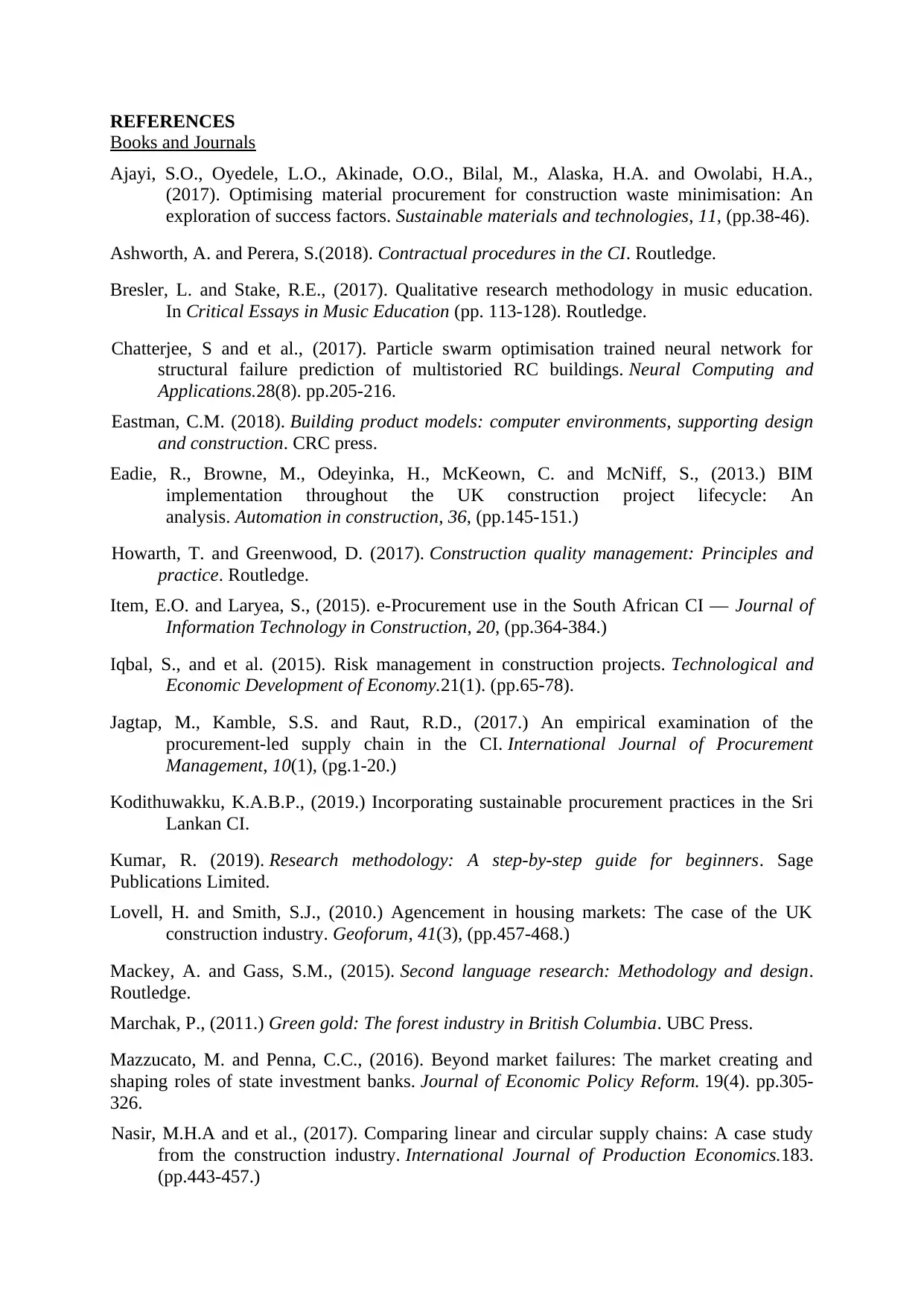
REFERENCES
Books and Journals
Ajayi, S.O., Oyedele, L.O., Akinade, O.O., Bilal, M., Alaska, H.A. and Owolabi, H.A.,
(2017). Optimising material procurement for construction waste minimisation: An
exploration of success factors. Sustainable materials and technologies, 11, (pp.38-46).
Ashworth, A. and Perera, S.(2018). Contractual procedures in the CI. Routledge.
Bresler, L. and Stake, R.E., (2017). Qualitative research methodology in music education.
In Critical Essays in Music Education (pp. 113-128). Routledge.
Chatterjee, S and et al., (2017). Particle swarm optimisation trained neural network for
structural failure prediction of multistoried RC buildings. Neural Computing and
Applications.28(8). pp.205-216.
Eastman, C.M. (2018). Building product models: computer environments, supporting design
and construction. CRC press.
Eadie, R., Browne, M., Odeyinka, H., McKeown, C. and McNiff, S., (2013.) BIM
implementation throughout the UK construction project lifecycle: An
analysis. Automation in construction, 36, (pp.145-151.)
Howarth, T. and Greenwood, D. (2017). Construction quality management: Principles and
practice. Routledge.
Item, E.O. and Laryea, S., (2015). e-Procurement use in the South African CI — Journal of
Information Technology in Construction, 20, (pp.364-384.)
Iqbal, S., and et al. (2015). Risk management in construction projects. Technological and
Economic Development of Economy.21(1). (pp.65-78).
Jagtap, M., Kamble, S.S. and Raut, R.D., (2017.) An empirical examination of the
procurement-led supply chain in the CI. International Journal of Procurement
Management, 10(1), (pg.1-20.)
Kodithuwakku, K.A.B.P., (2019.) Incorporating sustainable procurement practices in the Sri
Lankan CI.
Kumar, R. (2019). Research methodology: A step-by-step guide for beginners. Sage
Publications Limited.
Lovell, H. and Smith, S.J., (2010.) Agencement in housing markets: The case of the UK
construction industry. Geoforum, 41(3), (pp.457-468.)
Mackey, A. and Gass, S.M., (2015). Second language research: Methodology and design.
Routledge.
Marchak, P., (2011.) Green gold: The forest industry in British Columbia. UBC Press.
Mazzucato, M. and Penna, C.C., (2016). Beyond market failures: The market creating and
shaping roles of state investment banks. Journal of Economic Policy Reform. 19(4). pp.305-
326.
Nasir, M.H.A and et al., (2017). Comparing linear and circular supply chains: A case study
from the construction industry. International Journal of Production Economics.183.
(pp.443-457.)
Books and Journals
Ajayi, S.O., Oyedele, L.O., Akinade, O.O., Bilal, M., Alaska, H.A. and Owolabi, H.A.,
(2017). Optimising material procurement for construction waste minimisation: An
exploration of success factors. Sustainable materials and technologies, 11, (pp.38-46).
Ashworth, A. and Perera, S.(2018). Contractual procedures in the CI. Routledge.
Bresler, L. and Stake, R.E., (2017). Qualitative research methodology in music education.
In Critical Essays in Music Education (pp. 113-128). Routledge.
Chatterjee, S and et al., (2017). Particle swarm optimisation trained neural network for
structural failure prediction of multistoried RC buildings. Neural Computing and
Applications.28(8). pp.205-216.
Eastman, C.M. (2018). Building product models: computer environments, supporting design
and construction. CRC press.
Eadie, R., Browne, M., Odeyinka, H., McKeown, C. and McNiff, S., (2013.) BIM
implementation throughout the UK construction project lifecycle: An
analysis. Automation in construction, 36, (pp.145-151.)
Howarth, T. and Greenwood, D. (2017). Construction quality management: Principles and
practice. Routledge.
Item, E.O. and Laryea, S., (2015). e-Procurement use in the South African CI — Journal of
Information Technology in Construction, 20, (pp.364-384.)
Iqbal, S., and et al. (2015). Risk management in construction projects. Technological and
Economic Development of Economy.21(1). (pp.65-78).
Jagtap, M., Kamble, S.S. and Raut, R.D., (2017.) An empirical examination of the
procurement-led supply chain in the CI. International Journal of Procurement
Management, 10(1), (pg.1-20.)
Kodithuwakku, K.A.B.P., (2019.) Incorporating sustainable procurement practices in the Sri
Lankan CI.
Kumar, R. (2019). Research methodology: A step-by-step guide for beginners. Sage
Publications Limited.
Lovell, H. and Smith, S.J., (2010.) Agencement in housing markets: The case of the UK
construction industry. Geoforum, 41(3), (pp.457-468.)
Mackey, A. and Gass, S.M., (2015). Second language research: Methodology and design.
Routledge.
Marchak, P., (2011.) Green gold: The forest industry in British Columbia. UBC Press.
Mazzucato, M. and Penna, C.C., (2016). Beyond market failures: The market creating and
shaping roles of state investment banks. Journal of Economic Policy Reform. 19(4). pp.305-
326.
Nasir, M.H.A and et al., (2017). Comparing linear and circular supply chains: A case study
from the construction industry. International Journal of Production Economics.183.
(pp.443-457.)
Secure Best Marks with AI Grader
Need help grading? Try our AI Grader for instant feedback on your assignments.
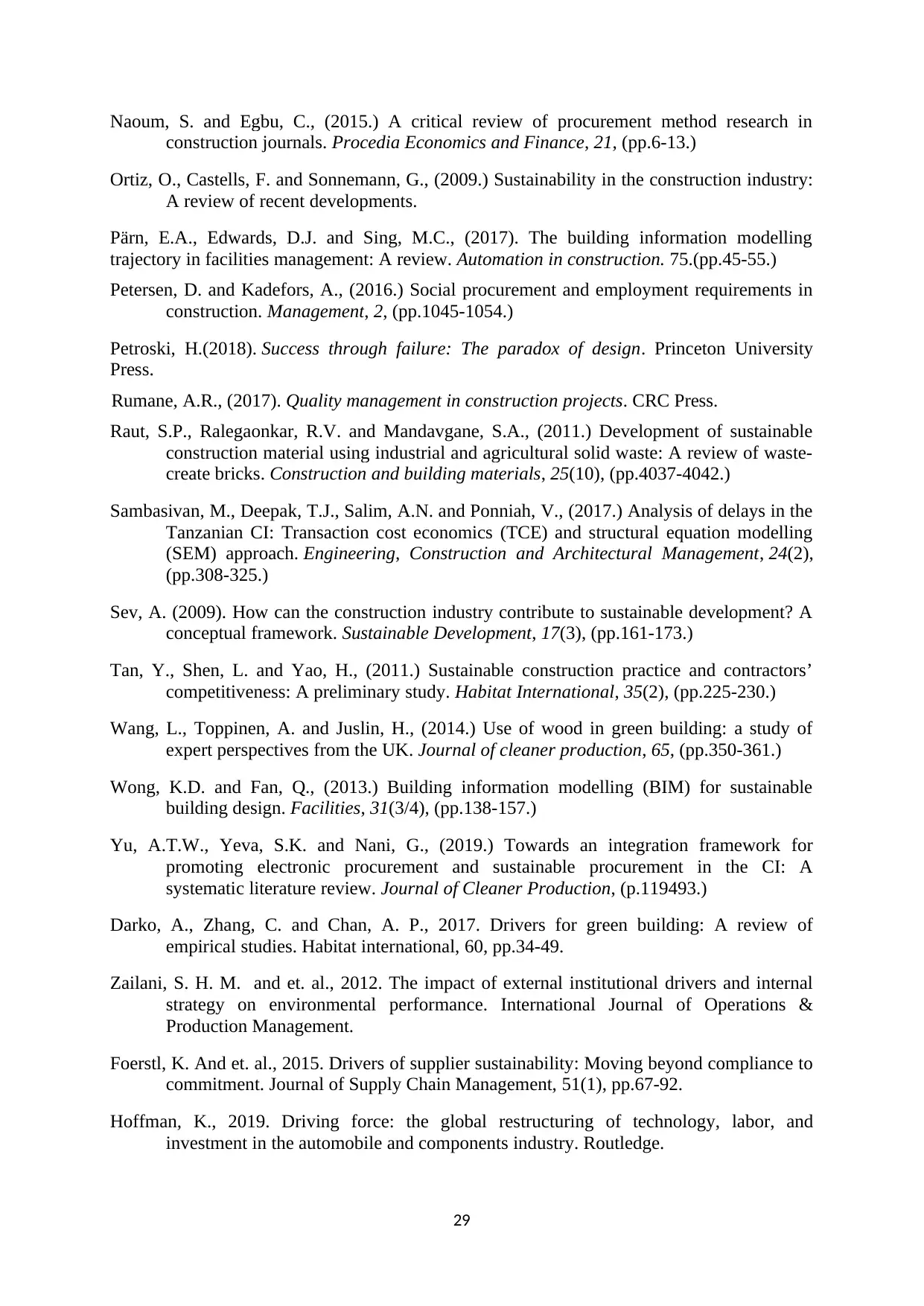
Naoum, S. and Egbu, C., (2015.) A critical review of procurement method research in
construction journals. Procedia Economics and Finance, 21, (pp.6-13.)
Ortiz, O., Castells, F. and Sonnemann, G., (2009.) Sustainability in the construction industry:
A review of recent developments.
Pärn, E.A., Edwards, D.J. and Sing, M.C., (2017). The building information modelling
trajectory in facilities management: A review. Automation in construction. 75.(pp.45-55.)
Petersen, D. and Kadefors, A., (2016.) Social procurement and employment requirements in
construction. Management, 2, (pp.1045-1054.)
Petroski, H.(2018). Success through failure: The paradox of design. Princeton University
Press.
Rumane, A.R., (2017). Quality management in construction projects. CRC Press.
Raut, S.P., Ralegaonkar, R.V. and Mandavgane, S.A., (2011.) Development of sustainable
construction material using industrial and agricultural solid waste: A review of waste-
create bricks. Construction and building materials, 25(10), (pp.4037-4042.)
Sambasivan, M., Deepak, T.J., Salim, A.N. and Ponniah, V., (2017.) Analysis of delays in the
Tanzanian CI: Transaction cost economics (TCE) and structural equation modelling
(SEM) approach. Engineering, Construction and Architectural Management, 24(2),
(pp.308-325.)
Sev, A. (2009). How can the construction industry contribute to sustainable development? A
conceptual framework. Sustainable Development, 17(3), (pp.161-173.)
Tan, Y., Shen, L. and Yao, H., (2011.) Sustainable construction practice and contractors’
competitiveness: A preliminary study. Habitat International, 35(2), (pp.225-230.)
Wang, L., Toppinen, A. and Juslin, H., (2014.) Use of wood in green building: a study of
expert perspectives from the UK. Journal of cleaner production, 65, (pp.350-361.)
Wong, K.D. and Fan, Q., (2013.) Building information modelling (BIM) for sustainable
building design. Facilities, 31(3/4), (pp.138-157.)
Yu, A.T.W., Yeva, S.K. and Nani, G., (2019.) Towards an integration framework for
promoting electronic procurement and sustainable procurement in the CI: A
systematic literature review. Journal of Cleaner Production, (p.119493.)
Darko, A., Zhang, C. and Chan, A. P., 2017. Drivers for green building: A review of
empirical studies. Habitat international, 60, pp.34-49.
Zailani, S. H. M. and et. al., 2012. The impact of external institutional drivers and internal
strategy on environmental performance. International Journal of Operations &
Production Management.
Foerstl, K. And et. al., 2015. Drivers of supplier sustainability: Moving beyond compliance to
commitment. Journal of Supply Chain Management, 51(1), pp.67-92.
Hoffman, K., 2019. Driving force: the global restructuring of technology, labor, and
investment in the automobile and components industry. Routledge.
29
construction journals. Procedia Economics and Finance, 21, (pp.6-13.)
Ortiz, O., Castells, F. and Sonnemann, G., (2009.) Sustainability in the construction industry:
A review of recent developments.
Pärn, E.A., Edwards, D.J. and Sing, M.C., (2017). The building information modelling
trajectory in facilities management: A review. Automation in construction. 75.(pp.45-55.)
Petersen, D. and Kadefors, A., (2016.) Social procurement and employment requirements in
construction. Management, 2, (pp.1045-1054.)
Petroski, H.(2018). Success through failure: The paradox of design. Princeton University
Press.
Rumane, A.R., (2017). Quality management in construction projects. CRC Press.
Raut, S.P., Ralegaonkar, R.V. and Mandavgane, S.A., (2011.) Development of sustainable
construction material using industrial and agricultural solid waste: A review of waste-
create bricks. Construction and building materials, 25(10), (pp.4037-4042.)
Sambasivan, M., Deepak, T.J., Salim, A.N. and Ponniah, V., (2017.) Analysis of delays in the
Tanzanian CI: Transaction cost economics (TCE) and structural equation modelling
(SEM) approach. Engineering, Construction and Architectural Management, 24(2),
(pp.308-325.)
Sev, A. (2009). How can the construction industry contribute to sustainable development? A
conceptual framework. Sustainable Development, 17(3), (pp.161-173.)
Tan, Y., Shen, L. and Yao, H., (2011.) Sustainable construction practice and contractors’
competitiveness: A preliminary study. Habitat International, 35(2), (pp.225-230.)
Wang, L., Toppinen, A. and Juslin, H., (2014.) Use of wood in green building: a study of
expert perspectives from the UK. Journal of cleaner production, 65, (pp.350-361.)
Wong, K.D. and Fan, Q., (2013.) Building information modelling (BIM) for sustainable
building design. Facilities, 31(3/4), (pp.138-157.)
Yu, A.T.W., Yeva, S.K. and Nani, G., (2019.) Towards an integration framework for
promoting electronic procurement and sustainable procurement in the CI: A
systematic literature review. Journal of Cleaner Production, (p.119493.)
Darko, A., Zhang, C. and Chan, A. P., 2017. Drivers for green building: A review of
empirical studies. Habitat international, 60, pp.34-49.
Zailani, S. H. M. and et. al., 2012. The impact of external institutional drivers and internal
strategy on environmental performance. International Journal of Operations &
Production Management.
Foerstl, K. And et. al., 2015. Drivers of supplier sustainability: Moving beyond compliance to
commitment. Journal of Supply Chain Management, 51(1), pp.67-92.
Hoffman, K., 2019. Driving force: the global restructuring of technology, labor, and
investment in the automobile and components industry. Routledge.
29
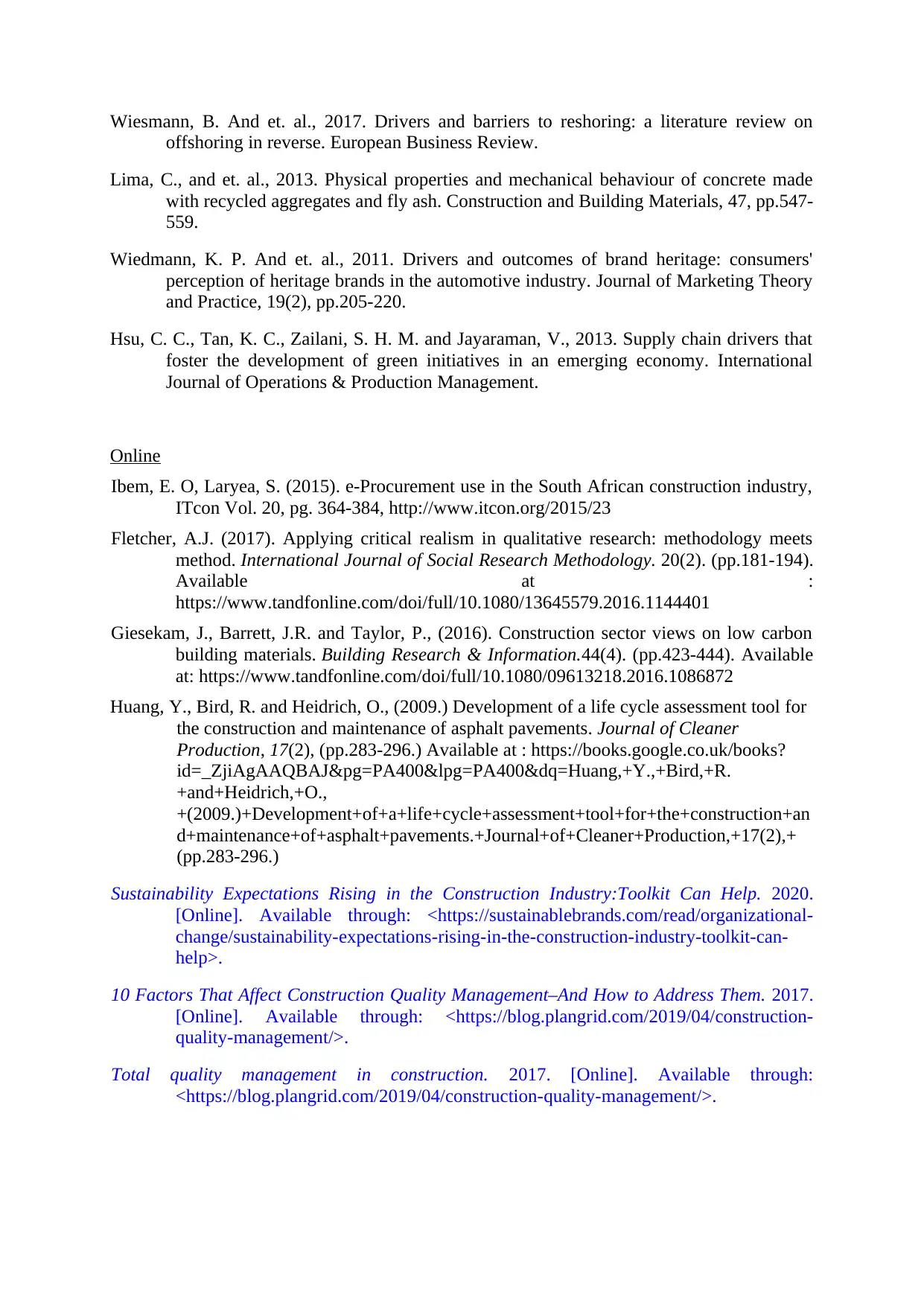
Wiesmann, B. And et. al., 2017. Drivers and barriers to reshoring: a literature review on
offshoring in reverse. European Business Review.
Lima, C., and et. al., 2013. Physical properties and mechanical behaviour of concrete made
with recycled aggregates and fly ash. Construction and Building Materials, 47, pp.547-
559.
Wiedmann, K. P. And et. al., 2011. Drivers and outcomes of brand heritage: consumers'
perception of heritage brands in the automotive industry. Journal of Marketing Theory
and Practice, 19(2), pp.205-220.
Hsu, C. C., Tan, K. C., Zailani, S. H. M. and Jayaraman, V., 2013. Supply chain drivers that
foster the development of green initiatives in an emerging economy. International
Journal of Operations & Production Management.
Online
Ibem, E. O, Laryea, S. (2015). e-Procurement use in the South African construction industry,
ITcon Vol. 20, pg. 364-384, http://www.itcon.org/2015/23
Fletcher, A.J. (2017). Applying critical realism in qualitative research: methodology meets
method. International Journal of Social Research Methodology. 20(2). (pp.181-194).
Available at :
https://www.tandfonline.com/doi/full/10.1080/13645579.2016.1144401
Giesekam, J., Barrett, J.R. and Taylor, P., (2016). Construction sector views on low carbon
building materials. Building Research & Information.44(4). (pp.423-444). Available
at: https://www.tandfonline.com/doi/full/10.1080/09613218.2016.1086872
Huang, Y., Bird, R. and Heidrich, O., (2009.) Development of a life cycle assessment tool for
the construction and maintenance of asphalt pavements. Journal of Cleaner
Production, 17(2), (pp.283-296.) Available at : https://books.google.co.uk/books?
id=_ZjiAgAAQBAJ&pg=PA400&lpg=PA400&dq=Huang,+Y.,+Bird,+R.
+and+Heidrich,+O.,
+(2009.)+Development+of+a+life+cycle+assessment+tool+for+the+construction+an
d+maintenance+of+asphalt+pavements.+Journal+of+Cleaner+Production,+17(2),+
(pp.283-296.)
Sustainability Expectations Rising in the Construction Industry:Toolkit Can Help. 2020.
[Online]. Available through: <https://sustainablebrands.com/read/organizational-
change/sustainability-expectations-rising-in-the-construction-industry-toolkit-can-
help>.
10 Factors That Affect Construction Quality Management–And How to Address Them. 2017.
[Online]. Available through: <https://blog.plangrid.com/2019/04/construction-
quality-management/>.
Total quality management in construction. 2017. [Online]. Available through:
<https://blog.plangrid.com/2019/04/construction-quality-management/>.
offshoring in reverse. European Business Review.
Lima, C., and et. al., 2013. Physical properties and mechanical behaviour of concrete made
with recycled aggregates and fly ash. Construction and Building Materials, 47, pp.547-
559.
Wiedmann, K. P. And et. al., 2011. Drivers and outcomes of brand heritage: consumers'
perception of heritage brands in the automotive industry. Journal of Marketing Theory
and Practice, 19(2), pp.205-220.
Hsu, C. C., Tan, K. C., Zailani, S. H. M. and Jayaraman, V., 2013. Supply chain drivers that
foster the development of green initiatives in an emerging economy. International
Journal of Operations & Production Management.
Online
Ibem, E. O, Laryea, S. (2015). e-Procurement use in the South African construction industry,
ITcon Vol. 20, pg. 364-384, http://www.itcon.org/2015/23
Fletcher, A.J. (2017). Applying critical realism in qualitative research: methodology meets
method. International Journal of Social Research Methodology. 20(2). (pp.181-194).
Available at :
https://www.tandfonline.com/doi/full/10.1080/13645579.2016.1144401
Giesekam, J., Barrett, J.R. and Taylor, P., (2016). Construction sector views on low carbon
building materials. Building Research & Information.44(4). (pp.423-444). Available
at: https://www.tandfonline.com/doi/full/10.1080/09613218.2016.1086872
Huang, Y., Bird, R. and Heidrich, O., (2009.) Development of a life cycle assessment tool for
the construction and maintenance of asphalt pavements. Journal of Cleaner
Production, 17(2), (pp.283-296.) Available at : https://books.google.co.uk/books?
id=_ZjiAgAAQBAJ&pg=PA400&lpg=PA400&dq=Huang,+Y.,+Bird,+R.
+and+Heidrich,+O.,
+(2009.)+Development+of+a+life+cycle+assessment+tool+for+the+construction+an
d+maintenance+of+asphalt+pavements.+Journal+of+Cleaner+Production,+17(2),+
(pp.283-296.)
Sustainability Expectations Rising in the Construction Industry:Toolkit Can Help. 2020.
[Online]. Available through: <https://sustainablebrands.com/read/organizational-
change/sustainability-expectations-rising-in-the-construction-industry-toolkit-can-
help>.
10 Factors That Affect Construction Quality Management–And How to Address Them. 2017.
[Online]. Available through: <https://blog.plangrid.com/2019/04/construction-
quality-management/>.
Total quality management in construction. 2017. [Online]. Available through:
<https://blog.plangrid.com/2019/04/construction-quality-management/>.

31
1 out of 31
Related Documents
Your All-in-One AI-Powered Toolkit for Academic Success.
+13062052269
info@desklib.com
Available 24*7 on WhatsApp / Email
![[object Object]](/_next/static/media/star-bottom.7253800d.svg)
Unlock your academic potential
© 2024 | Zucol Services PVT LTD | All rights reserved.





